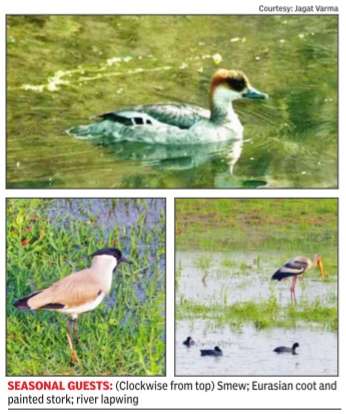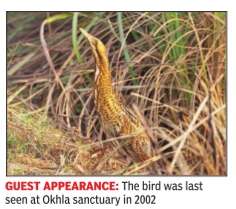Delhi: Birds
This is a collection of articles archived for the excellence of their content. |
Okhla sanctuary
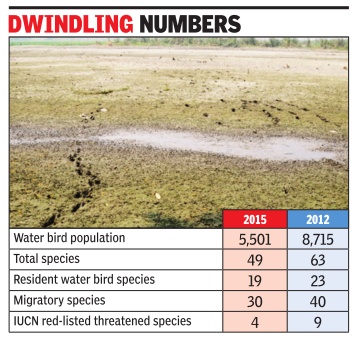
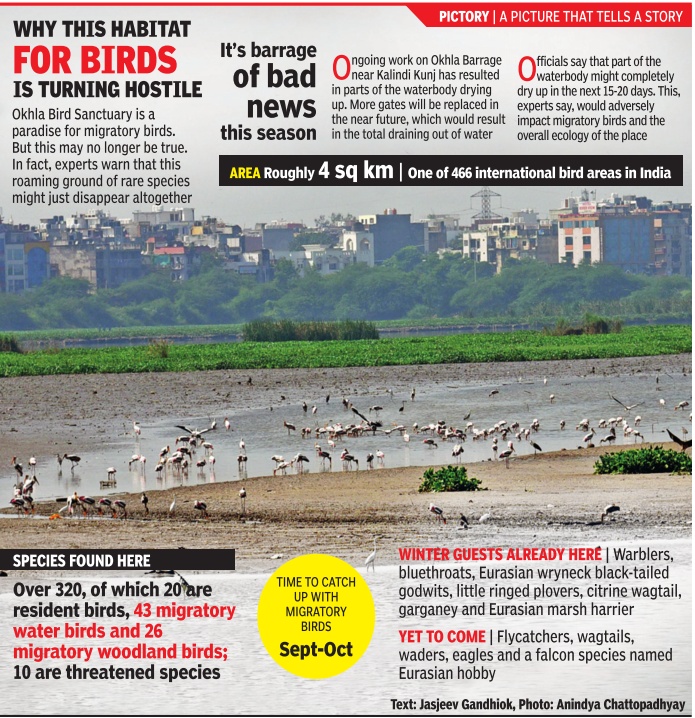
The Times of India, September 26, 2017
Barrage work leaves Okhla sanctuary dry
Okhla Bird Sanctuary is in a precarious state with vast stretches of its wetlands parched. Water has been diverted because the Uttar Pradesh irrigation department is changing three metal gates at the Okhla barrage. Officials said water would be released back into the wetlands only after April 24.
Birders say the change in water levels may impact the habitat. The irrigation department, however, insists that the barrage gates have to be maintained every year. Officials claim that the gates have been corroded because of the poor water quality in Yamuna. “We have to do our annual maintenance work.But this time it will take us longer because three barrage gates have to be changed,“ said one of them.
But birders are worried that the seasonal guests will give Okhla a miss. “April onwards the breeding season starts for resident water birds like spot-billed duck, purple swamphen, little grebe, purple heron, common moorhen and others. Some migratory birds from within the country also come for breeding like the lesser whistling duck or streaked weaver. I think now they have to abandon the sanctuary , skipping their annual breeding,“ said T K Roy ,a birder and Asian Waterbird Census coordinator for NCR.
“I know for sure that the authorities managing the sanctuary don't want any birders to go there. This is mainly because of their nexus with the builders and possibly they want to kill the sanctuary as well. Once I was charged Rs 500 just to take a camera inside,“ said a birder on condition of anonymity . There are also complaints of too many vehicles being allowed to use the road inside the sanctuary and very little ecological buffer area that can preserve the habitat. Birders say about seven to eight years ago close to 50,000 ducks could be seen during the season.
The only saving grace this time is that the maintenance work by the irrigation department has been rescheduled to March and April instead of October. In 2013, it was carried out in October-November when migratory species start arriving from Central Asia and Europe. Birders stressed that if maintenance is absolutely unavoidable then it should be wrapped up within a few days and not stretch up to a month.
“We had requested them not to carry out the work in October-November that's why they are doing it now. All the migratory birds are gone except northern shoveler and Eurasian wigeon. We should understand that the wetland and the sanctuary were created because of this barrage and it has to be maintained,“ said a UP forest department official.
THE BIRDS
Asian palm Swift
2022, 1977
July 28, 2022: The Times of India
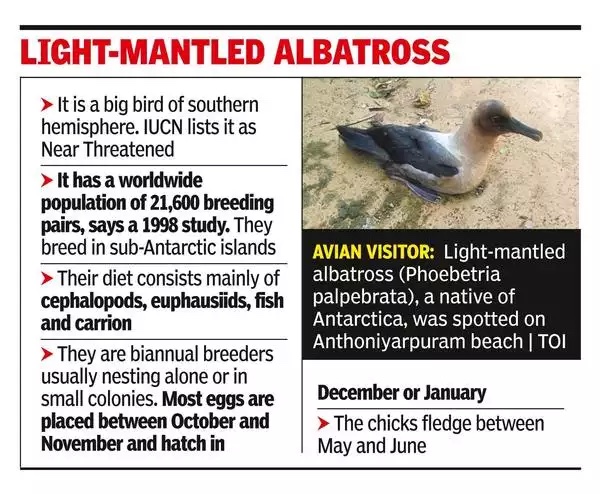
From: July 28, 2022: The Times of India
MADURAI: Two bird researchers have recorded sighting of a light-mantled albatross (Phoebetria palpebrata), a native of Antarctica, on Anthoniyarpuram beach in Rameswaram island on September 8, 2020. This was published in a peer reviewed journal called “Journal of Threatened Taxa’. The bird which is listed as ‘near threatened’ on the IUCN Red List has not been sighted previously in south Asia or Oriental region.
H Byju of Centre of Advanced Study in Marine Biology, Annamalai University, and N Raveendran from Iragugal Amritha Trust in Madurai, who published it said it was a mystery how the large pelagic bird reached Rameswaram. When Raveendran and local fishermen spotted the bird, it was exhausted and unable to fly. The forest department and local fishermen took care of it, provided water and feed before releasing it again. “We were wonder-struck about this spotting because it is very unusual to find an Antarctic bird in this region. The bird was an adult, and we don’t know how it could have strayed into the Gulf of Mannar which is 7,000 km to 8,000 km away from its usual nesting sites,” said Raveendran.
These birds maintain a circumpolar distribution in the southern ocean, mainly south of the sub-Antarctic convergence. They breed on several sub-Antarctic islands and forage over cold Antarctic waters. The duo did exhaustive research about the bird’s straying before subjecting their finding to international peer review.
“We had to rule out any possible storms or cyclones that could have brought this bird here. But our study revealed none. So we sent our study for international peer review and they concluded that it is for the first time light-mantled albatross is found in India or Asia,” said Byju. Behavioural studies on the bird found that they have no association with high or low pressure systems in the atmosphere for foraging. The best assumption is that it strayed due to wind patterns or storms but there were no storms when the bird was spotted, the researchers say. In June, the duo had sighted Arctic skua, also known as Parasitic jaeger, in Dhanushkodi, its third spotting in Tamil Nadu.
Eagles
Black eagle
Kushagra Dixit, January 14, 2022: The Times of India
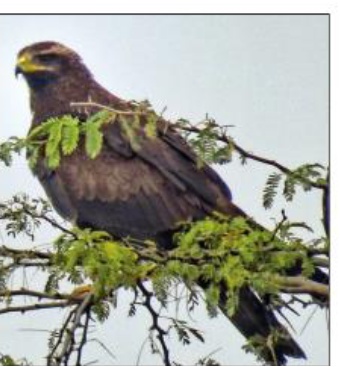
From: Kushagra Dixit, January 14, 2022: The Times of India
New Delhi: In a rare sighting, birders have spotted the Black eagle in Delhi after three years. Experts have called this a rare phenomenon in the Aravalis, which in their words is “one of the least researched ecosystems in the world”. One of the top predators, the Black eagle is a hunter and not a scavenging species found in the hills of Eastern and Western Ghats and the Himalayan foothills. An almost entirely black bird that can grow up to 81cm, this bird of prey has a grey-yellow beak with a black tip and yellow feet.
It was first sighted in Delhi in 2012. Since then, the bird was spotted only 5-6 times in the city and neighbouring areas. “It’s a very rare eagle to be seen here.
The last time it was seen here was in January 2019 in Asola Bhatti Wildlife Sanctuary. The bird was first sighted this season at Sanjay Van in November last year,” said Sohail Madan of Bombay Natural History Society.
Experts said this was a good sign for the ecology and a matter of research to conserve the Aravalis. “It’s an important finding. As the Black eagle is a hunter, it means it is getting food and a conducive environment here. It mostly resides in the thick rainforests of the Ghats. It was spotted some 10 years ago in this region. This means the Aravalis are more important than presumed. This is one of the least studied ecosystems in the world,” said KS Gopi Sundar, scientist at Nature Conservation Foundation and co-chair of IUCN, Stork, Ibis and Spoonbill Specialist Groups.
“Since the nearest Ghats are hundreds of kilometres away, there is a possibility that either there is a connectivity between them and the Aravalis or the Himalayan foothills. There may be some rich patches in the Aravalis. Recently, some rare birds and butterflies were spotted in the region, which was a call to preserve this ecosystem,” added Sundar.
Sambhav Jain and Harshul Thareja, who spotted the eagle, asserted that they had to get the pictures identified. “We spotted one juvenile perched on a Prosopis tree while coming back from Asola on January 4. We spotted one in flight again on January 12. We got the photos identified by experts as we were confusing them with the Greater spotted eagle and Imperial eagle because Black eagles are rare in this region,” said Jain, a Delhi-based birder.
Lesser fish eagle
Oct 10, 2019: The Times of India
Birders making their way to Sanjay Van on Tuesday were in for a surprise. Among the regular sightings made, a ‘large raptor with a white belly’ caught their attention. A closer look revealed that the bird was a lesser fish eagle—a bird that has not been recorded in the capital before. The bird is generally seen in the Himalayan foothills, and experts say that it is likely to be a vagrant. In Delhi, over 450 bird species have already been recorded.
Dr Surya Prakash, a birder and a zoologist from the JNU, spotted the bird on Tuesday along with other birders. He said that this is the first photo documentation in Delhi with an unconfirmed report of it being sighted in 2014 as well.
“This is probably the first confirmed spotting of the bird in Delhi. Although another birder, Yogesh Parasar saw one in October fleetingly, there were no records. Sightings have also been reported from Corbett and from Ranthambore. If we continue to see it, we may be able to derive a trend,” said Surya Prakash.
Chandra Bhushan, another birder, said that it was spotted around 9:30 am by their group. “We spotted a large raptor with a white belly which was photographed by several of us. We then checked multiple times and found it to be a lesser fish eagle, a bird that is only seen in high altitude areas. It is hard to tell why it came to Delhi, since it is not a migratory bird,” said Bhushan.
Nikhil Devasar, founder of Delhi bird and an ardent birder, said with birding becoming a popular hobby, more and more species were getting recorded in the national capital.
Egyptian vultures
Sighted in 2021
Priyangi Aagrwal, Oct 16, 2021: The Times of India
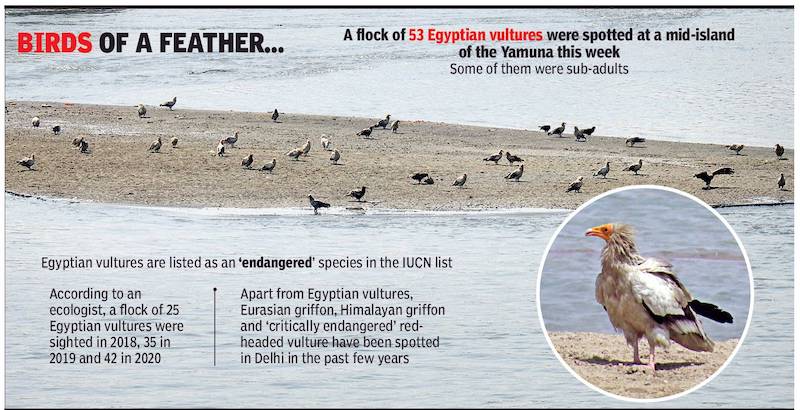
From: Priyangi Aagrwal, Oct 16, 2021: The Times of India
A flock of 53 Egyptian vultures, a rare sight in the capital, were spotted on a sandy mid-island on the Yamuna this week. Egyptian vultures have been listed as an endangered species in the IUCN list of threatened species. As vultures are scavengers, they play an important role in the ecosystem.
T K Roy, an ecologist who spotted the flock, said his field observations over the years revealed that the population of Egyptian vultures had been gradually rising. A flock of 25 Egyptian vultures was recorded in 2018, followed by a flock of 35 in 2019 and 42 in 2020, he added.
“Egyptian vultures prefer isolated places for roosting or resting. In Delhi, I have mostly recorded them on some middle islands on the Yamuna, apart from Bhatti Mines and Ghazipur landfill areas,” said Roy, who is also the state coordinator of Asian Waterbird Census. “They are not seen throughout the year in the city due to disturbance (feral dogs and human intervention) and lack of food. Habitat loss is another major factor as the vultures do not find safe and isolated islands on the Yamuna when there is a fluctuation in the water level.”
He said Egyptian vultures were mostly spotted between September and January. “The population is slowly rising because of the complete ban on diclofenac and growing awareness among people on vulture conservation,” said Roy. Diclofenac is an anti-inflammatory drug that has a toxic effect on vultures.
Besides their normal food habit of consuming carrions, the species now feeds on available dumped bio-degradable garbage at the dumping grounds, Roy added.
Surya Prakash, a retired scientific officer at JNU and an environmentalist, said, “Egyptian vultures with dark grey bill is a migratory (winter) while the other one with pale yellow bill is a resident. In February 2019 and 2020, on Big Bird Day, our team counted 53 and 47 Egyptian vultures on electrical pylon on Gurgaon-Faridabad Highway.”
Southern Ridge, JNU, Sanjay Van, Neela Hauz, Asola, Bhatti Mines, Ghazipur Mandi, Aravalli Biodiversity Park and Yamuna Biodiversity Park are the main hotspots to observe Egyptian vultures in Delhi, he added.
Sohail Madan of Bombay Natural History Society said, “Egyptian vultures, once a common sight in Delhi, have now become rare. They have been uplifted from vulnerable to endangered species in the IUCN list.”
Eurasian griffon, Himalayan griffon and critically endangered red headed vulture have also been photographed in Delhi in the past few years.
Flamingos
2018: pollution in Najafgarh lake
Is pollution taking a toll on flamingos in Najafgarh?, December 4, 2018: The Times of India
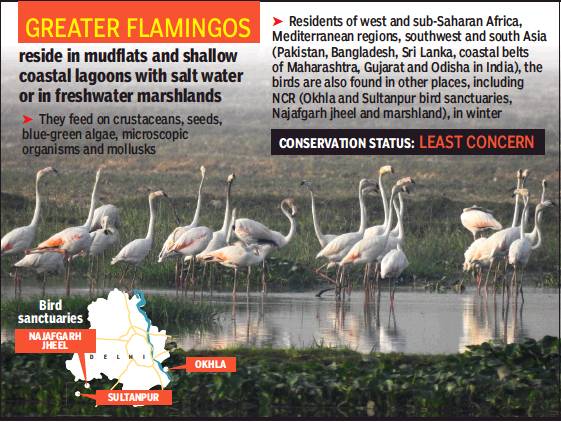
From: Is pollution taking a toll on flamingos in Najafgarh?, December 4, 2018: The Times of India
Study Says Birds Consuming Toxic Food From Drain Water
The Greater flamingo, which arrived a few years ago and settled in the Najafgarh drain, may be under serious threat from pollution. A research by students of Ambedkar University suggests that the birds are consuming insects and other sources of food (algae, molluscs and crustaceans) that have turned toxic by the polluted water, which may eventually lead to a complete decline in their population.
Experts said there are enough examples of birds, both domestic and migratory, that have disappeared due to the high levels of pollution and the threat on flamingos should be taken seriously.
Researchers from AUD’s Centre for Urban Ecology and Sustainability (CUES) visited Najafgarh jheel and marshland areas earlier this year to conduct a census of the birds. They found 565 Greater flamingos there. However, they also found the waterbody highly prone to pollution from industrial waste.
Over the last few years, the Greater flamingo flocks have started skipping their traditional stop-overs, Okhla and Sultanpur bird sanctuaries. However, the AUD research mentions that the shift of location may not be good for these aquatic birds as the Najafgarh drain is polluted.
Suresh Babu, ecologist at CUES, said, “The drain is heavily polluted as it receives industrial effluents from Haryana and other adjoining areas. This may affect their food habits and eventually their health.”
Ecologist Faiyaz Khudsar said that the birds may have shifted from Okhla to the drain looking for their food source which they only find in shallow waters.
The AUD research students are currently monitoring the birds at the site and their movement and habits, while also looking for possible effects of pollution.
However, other experts like birder Anand Arya said that though heavy metal present in waterbodies can be harmful for birds, since flamingos feed mostly on algae the impact of pollution may be minimal on them. “The flamingos should still be looked with seriousness as many birds, especially singing birds, have been affected by the high pollution at Okhla sanctuary,” he added.
Gulls, brown-headed
2018
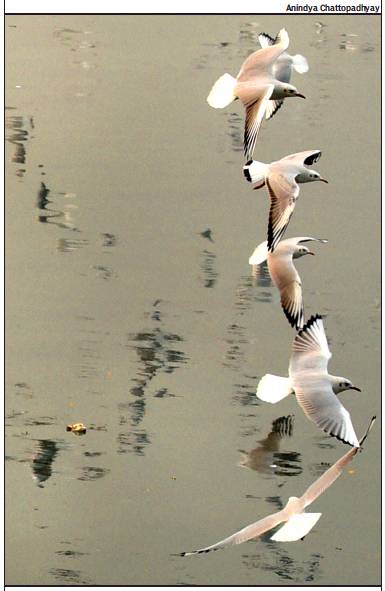
From: November 10, 2018: The Times of India
See graphic:
Brown-headed gulls are being seen on the Yamuna in Delhi. These birds are found in the plateaus of Central Asia, but migrate to South Asia in the winter
Herons
2019: numbers increase
Jasjeev Gandhiok, April 28, 2019: The Times of India
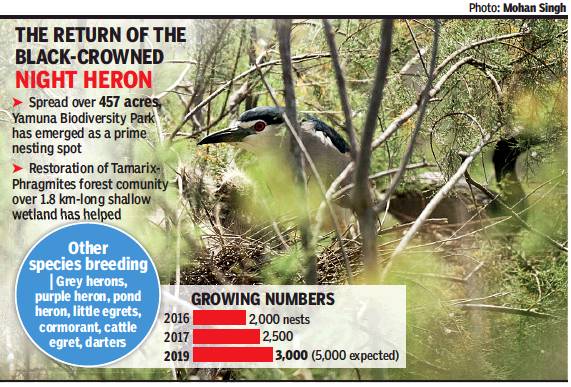
From: Jasjeev Gandhiok, April 28, 2019: The Times of India
At Yamuna Biodiversity Park, heron count cheers
New Delhi:
To birders delight, Delhi’s Yamuna Biodiversity Park (YBP) may witness its highest count of black-crowned night herons nesting there this year, a park official said.
YBP is considered as Delhi’s biggest breeding ground for the species — a resident bird — and experts said a good monsoon last season may have contributed to the high numbers.
While 2,000-2,500 nests were counted in 2016 and 2017, the number this year has already touched 3,000 and may go up to 5,000 by the end of the nesting season. The birds usually arrive by March for breeding and stay till September. Faiyaz Khudsar, scientist-in-charge, YBP, said the number of eggs has already been laid and hatched over the last month.
“At this stage, it appears to be the largest nesting in terms of numbers, and we could well see over 5,000 nests. We started developing a tamarix-phragmites forest community in 2003 and its effect started to show from 2012. With time, a healthy heronry has been developed,” said Khudsar.
With several breeding grounds like Rajghat being destroyed, ornithologists said, the species had almost vanished from Delhi 15 years ago. To bring them back, park officials grew the tamarix-phragmites forest spread over 1.8km inside the park, and now, it is known as a good nesting site for these birds.
“The forest has thick vegetation and the canopy is not too dense on top. This is ideal for nesting. The species also feeds on fish, and with a good monsoon last year, the water level is quite high, which has helped,” said Khudsar.
Ranjit Lal, a birder, said YBP could be one of the largest breeding sites in Delhi. “We used to see large numbers earlier at the Delhi zoo, but the sightings have gone down with time. These species ideally require water and enough fish nearby, which the biodiversity park now has,” he said.
Raptors
Northern goshawk
Kushagra Dixit, February 28, 2022: The Times of India
New Delhi: In a first for Delhi, birders have recorded the presence of Northern goshawk, a medium-sized raptor often spotted in the Himalayas that migrates to the plains in winter. The bird was photographed on Saturday during the last assessment of raptors for this season at Asola Bhatti Wildlife Sanctuary. Believed to be the “true hawk”, the bird is mostly displayed majestically in the portraits of Guru Gobind Singh, the tenth Sikh guru, thus making it the state bird of Punjab. Since the sighting was unusual for Delhi, the birders had to confirm that it was actually a Northern goshawk. The watchers felt the bird may have been present in the city earlier too, but due to its resemblance with other species, like Eurasian sparrowhawk and Cooper’s hawk, and lack of photographic evidence, it was never confirmed to have visited the capital. “A large number of birders spotted it during the annual raptor count organised at Asola Bhatti. It’s the power of citizen science. As more people are getting into birding, we have more observations and a better understanding of the whole region, which is the entire purpose of birding,” said Sohail Madan from Bombay Natural History Society. Raptors come from all over Europe and follow the trails of migratory birds, especially ducks, on which they prey. Normally seen in the Himalayas, the Northern goshawk is about 50-61cm in length and it breeds in Europe.
Nazes Afroz, a birder, said, “Raptors are rarely seen perched on trees. During the count, a young birder, Ateesh, pointed towards the raptor while it was circulating low. It later disappeared behind a hillock. When it reappeared, it looked like a Shikra as it was whitish, but looked bigger. We played back the shots and the first impression was of a Eurasian sparrowhawk. ”
“The bird looked larger and had very fine bards in the underparts. The bards were beyond the legs, almost touching the tails. There were also very strong sets of white marks over the eyebrows. There were also dark patches around the eyes. We then compared the photos with an image of a Northern goshawk in flight,” added Afroz.
Another unusual sighting in the region in the past two years included the Himalayan bluetail in Mangar. “It may have been spotted earlier, but there are no pictures to confirm it. The bird is a very elegant species,” said Bikram Gerywal, a bird expert and a Delhi-based writer.
Sparrows
2018: dwindling numbers
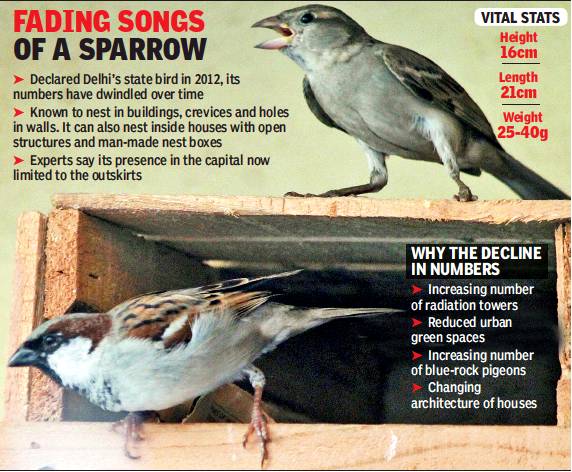
From: Jasjeev Gandhiok, Where have all the sparrows gone? Blame it on vanishing urban nesting spaces, March 20, 2018: The Times of India
AS DELHI MAKES RAPID STRIDES IN TERMS OF INFRASTRUCTURAL GROWTH, IT APPEARS TO BE COMING AT A HUGE COST
Once a bird that was synonymous with the chirping heard outside every home, the house sparrow is today a rare species in the capital — despite being Delhi’s state bird. And while the others celebrates World Sparrow Day on Tuesday, experts in the city ruing that the brown presence has disappeared due to reduction in urban nesting spaces and the presence of the blue rock pigeon which too is taking over the sparrows’ nesting areas.
Experts say it is hard to estimate the numbers left in the city, but most sparrows have shifted to the outskirts of Delhi. Said birder Nikhil Devasar: “The sparrow concentration has shifted to forests and urban villages outside Delhi. The fact is urban areas now have fewer trees and greenery where the sparrows can nest. Of course, the blue rock pigeons have also colonised places where sparrows can make nests.”
Since 2010, March 20 has been designated World Sparrow Day to highlight the decreasing presence of the once common bird. In 2012, the sparrow was adopted as the state bird of Delhi.
Experts say the birds act as an ecological indicator and the dwindling numbers signify urban lifestyle changes. “House sparrows have co-existed with humans, but in the last couple of decades they haven’t been able to keep up with architectural and lifestyle changes,” explained Sohail Madan, Asola centre manager, Bombay Natural History Society. “Houses used to be open and there were places for sparrow nests, but these have disappeared. Sparrows are moving to greener areas. We are seeing hundreds of them in Asola, for instance.”
Faiyaz Khudsar, scientist in charge at the Yamuna Biodiversity Park, was almost certain that non-availability of nesting space was one of the biggest reasons for the flight to the outskirts. “Today’s urban constructions are not sparrow-friendly — the bird cannot find resting space and finding food is also difficult because availability of insects and worms has reduced due to the use of insecticides and pesticides,” said Khudsar.
Experts confirmed that the species still lived in substantial numbers in green areas such as Lodhi Garden, Sanjay Van and the biodiversity parks around the capital. In fact, Dr Surya Prakash, zoologist at JNU, asserted the birds could be brought back to the city if feeders and nest-boxes were provided in large numbers. “We have worked in Shankar Vihar for a few years and seen sparrow population increasing. Delhi needs efforts of this sort,” Prakash said.
2019: dwindling numbers, and a revival
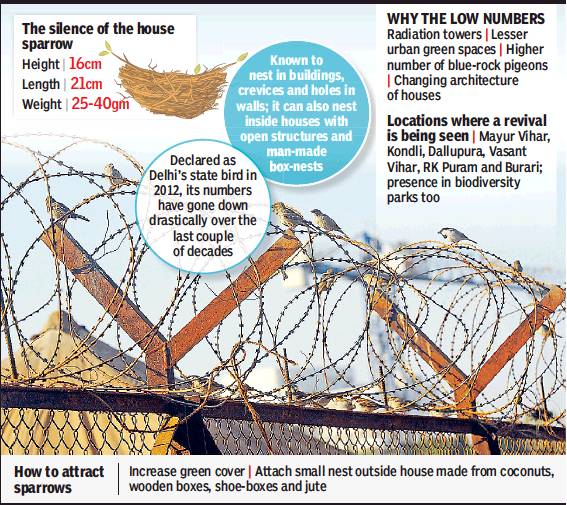
From: Jasjeev Gandhiok, Tweeting live: Sparrows find their nesting space, March 21, 2019: The Times of India
A couple of decades ago, the house sparrow’s chirping was a common sound outside every household in Delhi, but their numbers have steadily dwindled over the years. Declared Delhi’s state bird in 2012, it has seen revival in small pockets around Delhi.
Experts cite urbanisation, reduced nesting spaces and greenery, rock pigeons and radiation from phone towers as some of the reasons for the sparrows making a gradual shift to the outskirts and urban villages instead of urban habitats where they earlier co-existed with humans.
“You can find them in areas with shrubs and bougainvillea, but the problem is the reduction of greenery in colonies. Highrise apartments are being built and trees being chopped to accommodate more parking, which leaves few places where they can nest,” said birder Nikhil Devasar.
Faiyaz Khudsar, scientist in-charge at Yamuna Biodiversity Park, said hundreds of sparrows continue to flock the park, but they need a habitat with enough greenery and roosting space. “Fossil evidences suggest human-dependent lineage of house sparrows. However, changes brought about by humans in and around their settlements led to the loss of their natural habitats, which resulted in their rapid decline. Lack of nesting space coupled with the loss of native grasses and their native insect herbivory made the house sparrow vanish from urban settlements,” he added.
“The reason they are in good numbers at the biodiversity park is because they get to roost in the trees. For feeding they go to the nearby villages. They love staying close to human settlements, but need enough greenery,” Khudsar said.
Since 2010, March 20 has been adopted as World Sparrow Day to highlight the decrease in their numbers. The birds act as an ecological indicator and their decrease in numbers could point to a change in lifestyle, experts said. “If you see a large number of sparrows, this is a general indication that the habitat is conducive and thriving. Houses that earlier had open spaces have also seen an architectural change, reducing their options,” said Sohail Madan, centre manager at Bombay Natural History Society in Asola.
However, all is not lost. Recent efforts have brought a positive change in certain neighbourhoods like Mayur Vihar, RK Puram, Vasant Vihar and Burari. Rakesh Khatri, founder of NGO Eco Roots Foundation, has produced over 35,000 handmade nests from 36 different types of materials, each of which has been placed in urban colonies.
“The more people put up such nests, the more these birds will return to our urban colonies. Parents are also quite active and want their children to learn such activities,” Khatri said. The other areas that have seen a revival include Dallupura, Vasundhara and Kondli.
Vultures
2019/ Himalayan Griffon vultures
Shilpy Arora, Nov 18, 2019: The Times of India
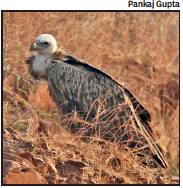
From: Shilpy Arora, Nov 18, 2019: The Times of India
It has been five years since the Himalayan vulture was spotted in the Delhi-NCR. So, when Vijay Dhasmana and Ram Veer spotted a flock of 15 at the Aravali Biodiversity Park, they were surprised.
“We often see Egyptian vultures here. But on Saturday, around 4pm, I saw vultures with very big wingspans. It was unusual. When it was roosting in the park, I took a few photos. Later, birders confirmed they were Himalayan Griffon vultures,” said Vijay Dhasmana, an ecologist from IAmGurgaon, an environment NGO.
Around the same time, Ram Veer, a birder from Saket in Delhi also spotted the vulture. “I had seen Himalayan vultures in the Himalayas earlier. It was surprising to see it here. I saw them land in the park,” he said. The following morning, Pankaj Gupta from the Delhi Bird Foundation spotted two Himalayan vultures. “I waited nearly two hours for sunlight so I could take better photos,” the north India coordinator of e-bird, an online database of bird sightings said.
The Himalayan Griffon, identified as a ‘near threatened’ species by the International Union for Conservation of Nature, is revered in Tibetan culture as the “feeder of the dead in the afterlife”. It moves in loose flocks from the Himalayan range to winter in peninsular India and has a distinct appearance, with an immense wing span. “There have been a few sightings in the past — the last was 2014 in Okhla — but it has not been very common in the region. I hope it winters in Delhi-NCR this year,” Gupta added.
And the way to ensure that is to protect the Aravalis. “The park’s flora and fauna attract these birds. There is a need to not only conserve but also increase that,” said Dhasmana. “Another major threat to vulture populations in the region had been diclofenac, a painkiller administered to animals. Vultures would ingest the medicine when they ate the carcasses, which would make their egg shells weak and difficult to hatch. This led to a decline in their population since the 1990s,” said Ram Veer. And while air quality has not shown a direct impact on migratory patterns, its long-term effect is yet to be seen and understood.
Waterbirds
Population: 2018-20
Paras Singh, January 3, 2021: The Times of India
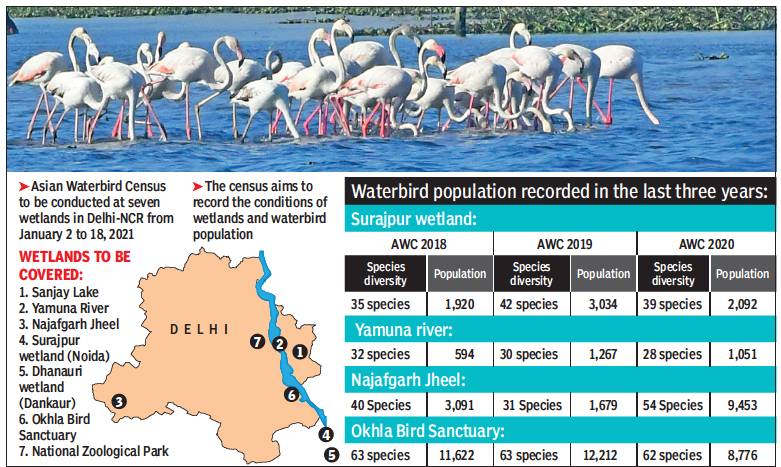
From: Paras Singh, January 3, 2021: The Times of India
See graphic:
The Waterbird Population in Delhi: 2018-20
Census, 2021: early results
Priyangi Agarwal, January 18, 2021: The Times of India
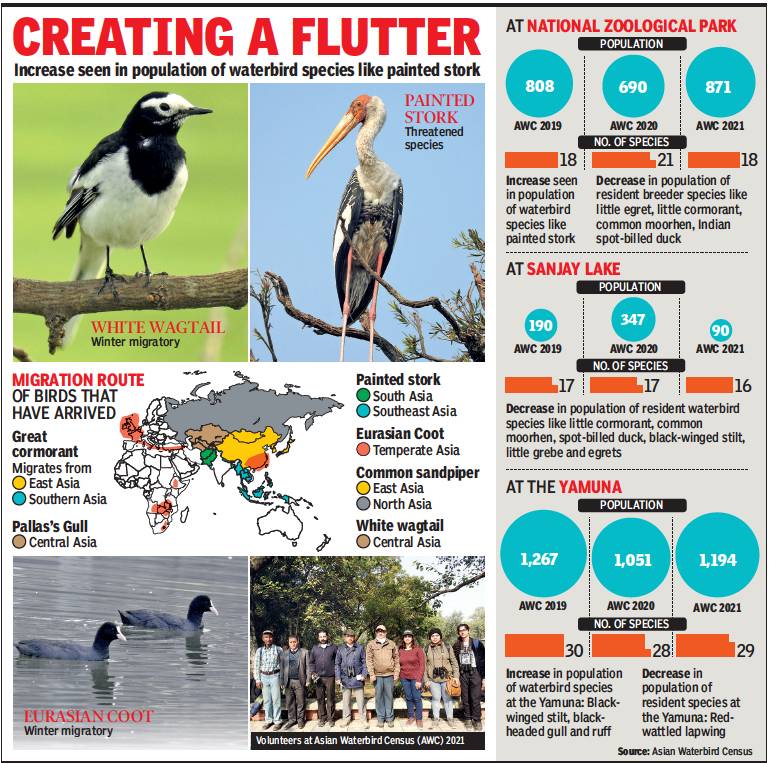
From: Priyangi Agarwal, January 18, 2021: The Times of India
The ongoing Asian Waterbird Census (AWC) shows an increase in the population of waterbirds at the 20km stretch on the Yamuna from Wazirabad barrage to Nizamuddin bridge, and National Zoological Park which has four wetlands. However, the population of waterbirds has decreased at Sanjay Lake.
AWC said the number of birds marginally rose from 1,051 in 2020 to 1,194 in 2021at the river. “Other smaller wetlands in the surrounding have dried up or are drying or are disturbed, and hence, the birds shifted to the Yamuna. The river is polluted and always shows fluctuating species population,” said T K Roy, AWC state coordinator. During the census, three bird species considered threatened as per IUCN list — River lapwing, Painted stork and Common pochard — were recorded. The count of two migratory species, Black-headed gull and ruff — and resident bird species Blackwinged stilt increased. While the number of resident species Red-wattled Lapwing decreased.
At Delhi zoo, AWC said the population of birds has shot up from 690 last year to 871 in 2021, mainly due to breeding of Painted storks, which is threatened species. However,the number of species diversity decreased to 18 this year as against 21. Birders said four wetlands situated inside Delhi zoo hosts both resident and migratory waterbirds.
Out of 18 species at the zoo, 15 are of resident waterbirds while three are of migratory waterbirds, including Painted stork, Eurasian coot and Common sandpiper. No other species of migratory ducks were recorded at the zoo this time. The population of Little egret, Little cormorant, Common moorhen and Indian Spot-billed duck — all resident waterbirds breeder at Delhi zoo — has decreased.
According to AWC, which is an annual survey to record the status of wetlands in Delhi-NCR, the population of birds at Sanjay Lake rose from 190 in 2019 to 347 in 2020. However, the survey stated that the number of birds has drastically reduced to 90 this year. The experts claimed that the number of birds has reduced as the wetland has been “converted into a sewage-polluted artificial lake.”
Experts claimed that the total number of birds has decreased due to degradation of wetland. “Sanjay Lake, which is an existing urban wetland in the heart of east Delhi, used to be a good habitat for waterbirds, including winter migratory waterbirds. It has now been converted into sewage polluted artificial concretised lake just for public entertainment and commercial activities without any sustainable management of the wetland,”the AWC state coordinator added.
Among the waterbird species whose population has gone down this year are Little cormorant, Common moorhen, Spotbilled duck, Black-winged stilt, Little grebe and egrets. Experts said waterbirds are one of the key indicators of a wetland’s health. Wetlands provide feeding, resting, roosting and foraging habitats for these species.
YEAR-WISE DEVELOPMENTS
2013-18
Number of birds documented: Big Birds Day, 2013-18
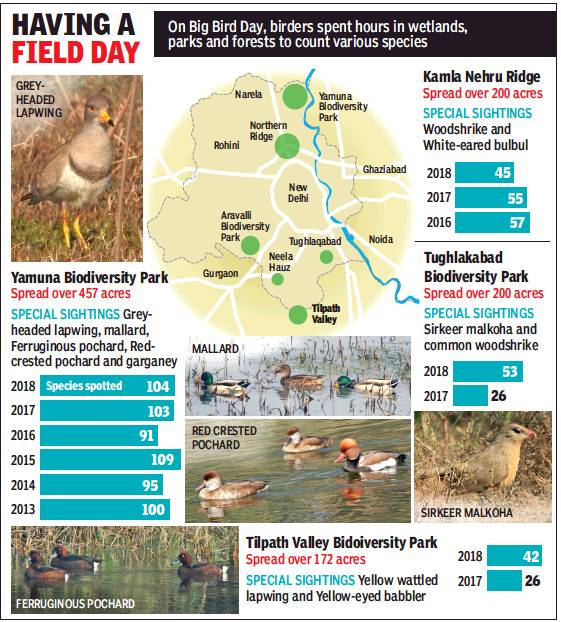
From: Birders flock together to get a count, February 19, 2018: The Times of India
See graphic:
‘Special sightings’ (of rare birds) on Big Bird Day in Delhi- NCR’s Bio-diversity Parks and the Ridge, 2013-18
October visitors
2017-19
Jasjeev Gandhiok, Nov 12, 2019: The Times of India
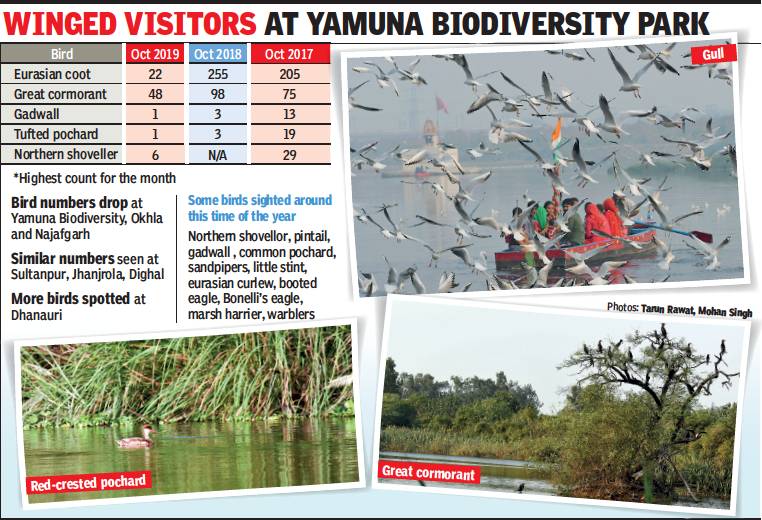
From: Jasjeev Gandhiok, Nov 12, 2019: The Times of India
The Yamuna Biodiversity Park (YBP) officials were delighted when they espied a red-crested pochard in the nature reserve in September. The migratory bird, which generally makes its way to Delhi in mid-November, had arrived well in advance this year. This pattern of early arrival has been observed in most other places in Delhi, though the number of migratory birds has been lower than normal in some locations, including at YBP.
“After the initial red-crested pochard sighting, we have not recorded any more arrivals,” admitted Faiyaz Khudsar, scientist in charge at YBP. “The number of other avian visitors, such as the Eurasian coot, gadwalls and great cormorants, is also lower than what was recorded by this time last year.”
By the end of October, over 200 Eurasian coot had reached the biodiversity park in 2017 and 2018. In comparison, this year the figure hovers at 18-22 sightings. Similarly, the highest count for great cormorants till the end of October this year was 48 compared with 98 and 75, respectively, in 2018 and 2017.
Is pollution to blame for the fewer migrants? Khudsar says no. The problems back ‘home’, or the place from where the birds started their flight, are more pertinent, he said. “For birds coming from Siberia, the variation in number could be because the temperatures there were higher than normal. This climatic change confuses the birds and affects their migration pattern,” explained Khudsar.
The scientist added that good monsoons in the Rajasthan had created suitable wetlands for birds to nest, and they may have stayed there rather than fly to Delhi.
Nikhil Devasar, who generally keeps a check on birds in Sultanpur and its outskirts, said he was unable to give a clear picture about migration because heavy pollution had forced his group to cancel multiple birding sessions. “The bird count has slowly started going up and we can expect more in December,” Devasar said. “It is tough to say if the number has been affected by pollution.”
Kanwar B Singh, another birder, pleaded the same, saying pollution had stopped their forays into bird habitats. Najafgarh, however, appeared more disturbed than normal, he said. “We will conduct a winter bird count on November 24, which should give us more precise numbers,” he assured.
Jaswinder Waraich refused to pinpoint the reason for the lower count but described the turnout at Okhla as ‘disappointing’ so far. “Birds have their own preferences when it comes to nesting. There are cycles of good and bad years. The condition of the habitat also plays a major role in their arrival,” noted Waraich.
Dr Surya Prakash, a zoologist at JNU, pointed out that some ‘late’ migratory species were yet to arrive, and a clear picture would likely emerge by end-December.
According to birders, the species that are here include the northern shovellor, pintails, gadwalls, common pochard, sandpipers, little stint, Eurasian curlew, booted eagle, Bonellis eagle, and warblers.
2015
February 2015: Visiting birds
Feb 23 2015
Neha Lalchandani
Rare birds fly into city
Birdwatchers have reported a host of rare birds in the city this season. The sightings, they say, are a result of luck and the proliferation of birdwatchers with better equipment. With the environment of Delhi becoming worse with every passing season, birders say that rare birds have become even more difficult to spot which is why these sightings become extremely important. Kanwar B Singh, a Delhibased birder, says that usually during active western disturbances when it snows in the hills, birds from the Himalayas migrate to the adjoining plains, which is why maybe some of these rare sightings take place in winter.
“The state of the city's wetlands and water bodies has deteriorated over the past few years and has resulted in a fall in the number of species seen here.These sightings have more to do with the increase in number of birders, using more sophisticated equipment and better communication that help in correctly identifying birds,“ he said.
One such rare bird seen in Delhi recently is the Smew, a species of duck which was last reported from the Delhi region in 1922 by Basil-Edwardes. On November 16 last year, Jagat Prakash Verma saw the bird in the Jhajjar district. Birders say it is a significant record as the bird is an extremely rare visitor to India and is a vagrant.
However, according to records of AO Hume, the bird could be seen regularly at the Najafgarh drain till the late 19 th century. The Red-necked phala rope, another rare bird to be spotted in India, was recorded by Sanjay , the bird guide at the Sultanpur bird sanctuary in the beginning of February . This was the first recorded sighting of the bird in almost 35 years. The phalarope migrates from the north Arctic to the tropical seas. “It was sheer chance that it was seen here.
There are a few records of the bird in India in the past few years but in Delhi, it is an extremely lucky sighting,” said Singh.
The Slaty blue flycatcher from the Himalayan forests was seen by Singh on January 31. “It tends to venture into the forests of the Himalayan foothills during winter. However, there has never been any sighting from the Delhi region. I was pleasantly surprised to see one blue-coloured male feeding on the ground next to the jogging track at Nehru Park on January 31,” he said.
Ultramarine flycatcher, another Himalayan species, spends the winter in the forests of Western Ghats. Its recent sightings in the Delhi region were in October 2013 at Sultanpur by Savithri Singh and then in January by at Sundar Nursery by Ratish Nanda.
The Oriental scops owl, a very small bird, was last seen in 1925 by Basil-Edwards till it was spotted once in Palam Vihar in 2013 and then at the Najafgarh drain in January 2015.
The Smoky warbler, which is fairly common in east India, was also never conclusively seen around Delhi till this winter. Several birdwatchers saw it at the Basai wetlands this season.
The Lemon-rumped warbler, a Himalayan bird that barely ever descends into the plains, was seen sitting on a tree by Udiyaman Shukla from his balcony near All India Institute of Medical Sciences (AIIMS).
Birds spotted in March 2015
It was birders' day out with rare finds
TIMES NEWS NETWORK The Times of India Mar 09 2015
Sea Duck Spotted In NCR After A Century
It started out as a gloomy morning because of rain and low visibility in some parts of the city but the day turned out to be an ecstatic one for birders. Teams who participated in the Big Bird Day 2015 on Sunday not only spotted a great variety of species but also some extremely rare ones. A team that was birding in Jhajjar's Bhindawas spotted Smew, a European sea duck that was last seen in NCR between 1920 and 1925.
After close to a century, the birders were thrilled that the small duck species that breeds in northern Taiga of Europe and Asia continues to be seen around Delhi.
Another team that went to the Sultanpur bird sanctuary spotted a White-bellied drongo which is also an important sighting as its population is declining. However, Smew was the highlight of the day . “It was spotted in 1881 by AO Hume, who was a great birder and the founder member of Indian National Congress. In 1922, it was seen near the capital by Basil-Edwardes. Recently, there were also reports of it being spotted in West Bengal's Gajoldoba,“ said Bikram Grewal, one of the organizers of Big Bird Day .
Suresh Sharma, who was part of the team that spotted the Smew, said they also saw a Peregrine falcon and an Indian spotted eagle, thanks to their powerful binoculars. “We spotted 178 species on Sunday . Officials are apathetic towards Bhindawas Bird Sanctuary,“ said Sharma.
About 300 people, divided in to 12-14 teams, participated in this year's Big Bird Day . It is one of the largest birding events in the country where people spend a day birding and then upload a list of their sightings on an online portal called eBird. It was started by the Delhibird group--created by Nikhil Devasar and Bikram Grewal--as an informal event held in February or March every year. The first Big Bird Day was held on February 22, 2004, when 236 species of birds were recorded in NCR. The results for this year will be collated in a week.
At Yamuna Biodiversity Park, a team of 20 participated and spotted 109 species between 8am and 10am. A flock of small Pratincole was also seen in the flood zone of Yamuna. At Aravalli Biodiversity Park, counting started early in the morning. A team of six birders participated and listed 69 bird species.
2015: Sunder nursery
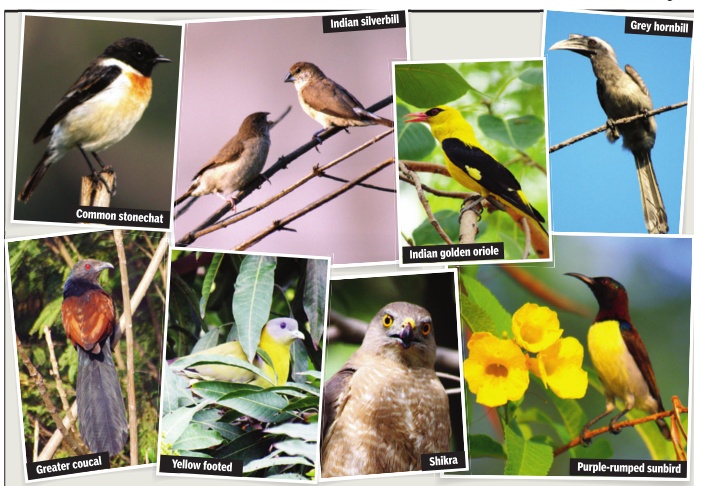
Apr 07 2015
Rare birds return to Sundar Nursery
Neha Lalchandani
A little off the beaten track, adjacent to Humayun's Tomb and next to a busy railway station is Sundar Nursery . Typically, one would expect to go there to buy plants but the 70-acre urban oasis is nowhere close to an ordinary nursery . This garden complex is replete with old trees and dotted with monuments dating back to the Mughal era. And it's after years of conservation work, the nursery , originally known as Azim Bagh, is back to its magnificent self. The revival of Sundar Nursery was taken up in 2007.Most of the land was hidden beneath tonnes of debris. The work of landscaping the nursery, along with restoration of 13 monuments, was taken up in 2009 by the Aga Khan Trust for Culture (AKTC) in partnership with CPWD.
The nursery was established by the British in 1913 to grow and develop plants for the new city of Delhi. It was taken over by the CPWD in 1945. At present, it houses the largest collection of tree species found in capital, including some rare ones.
The focus is also on developing a wide range of habitats within the nursery . It is fast becoming a fascinating site for birdwatching. Officials said the project aims at ecological restoration too.
“The landscape master plan was developed by architect M Shaheer and includes zones for a variety of functions. It has an exclusive zone for ground nesting birds such as peafowl. The complex used to be a key bird habitat till 1970s, but large-scale dumping of construction waste ruined the area. Our aim was to redevelop it with native flora and fauna. At present, the nursery has 1,800 large trees now mapped on a GIS system.Additionally , 5,000 tree saplings of over 200 native species have been planted. These species are mostly fruit-bearing and have been planted to attract more birds,“ said an official.
To develop it as a microcosm of Delhi, efforts are on to replicate the ridge biodiversity, along with khadar (riverine), bangar (alluvial) and dabar (marshy) zones.And since birds have started returning to the nursery , one can spot the black kite, grey hornbills, woodpeckers, yellow-footed green pigeons, spotted owlet, Indian roller, white-throated kingfisher, Eurasian hoopoe, Indian grey hornbill, brown-headed barbet, coppersmith barbet, Hume's leaf warbler, common tailorbird, oriental white eye and green bee eater.
Cormorants and painted storks--with their habitat at nearby Delhi zoo--too frequent the nursery even though many major water bodies are yet to be developed.“Water bodies are being developed to attract more birds.The earth embankments along the water bodies are already seeing kingfishers. In addition to that, denselyplanted zones have been established for ground nesting birds such as peafowl and francolin. These will provide a habitat secure from stray dogs,“ the official said.
Currently , AKTC has 77 species of birds, including ultramarine flycatcher and Eurasian golden oriole, on record in the Sundar Nursery area.
2015: Common pochard, steppe eagle and other dwindling birds
The Times of India, Nov 03 2015
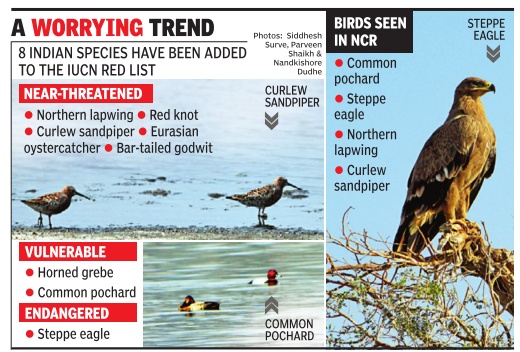
Jayashree Nandi
Common pochard now rare in NCR
Conservationists were alarmed in Nov 2015 to find one of NCR's once most-commonly sighted wetland bird, common pochard, to have been labelled `near-threatened' in the latest red list of birds released by International Union for Conservation of Nature (IUCN) for 2015 because of its depleting number. The duck was in the `least concerned' category till last year. But IUCN's latest report is proof of how wetlands here are either disappearing or are not able to support aquatic and bird life any more. The IUCN red list now has a total of 180 bird species in India in the threatened category as against 173 last year. This year, it has eight new species from India--northern lapwing, a grassland bird; water birds like red knot, curlew sandpiper, Eurasian oystercatcher, bar-tailed godwit, horned grebe, common pochard and a raptor--steppe eagle, which have been added to the list. The inclusion of common pochard and steppe eagle, a regular winter migrant bird, has shocked a lot of birders in NCR. “It is quite alarming. Their number is fast depleting. I think many factors like habitat loss and changing weather pattern are at play . I was in Maguri Beel in Assam yesterday and didn't spot a single duck. So it's not like only NCR birds are depleting. It's across the country ,“ said Bikram Grewal, author and birder. Even steppe eagle was earlier spotted a number of times at places like Aravalli Biodiversity Park and Asola Bhatti Sanctuary . It's a raptor that comes down to various grassland and ridge areas of NCR in the colder climes. Experts said grassland and waterbirds are the worst affected because there is little appreciation or understanding of these habitats. “They are in danger because here are not effective laws to protect these habitats.Grasslands and wetlands are still considered as `was eland' in many government records, so even a local revenue officer can give these habitats for other uses, while he or she cannot do this to fo rested areas as forest is pro tected under many laws. As long as we have this attitude both these habitats will keep on disappearing,“ said Asad R Rahmani, senior scientific adviser, Bombay Natura History Society (BNHS). The most pertinent ex ample is that of 3,000 hecta res of grassland in Karnata ka, a habitat for the critical ly-endangered great Indian bustard, which has been al legedly handed over to DRDO and other organisa tions. Conservationists are vehemently opposing this. Another wetland bird curlew sandpiper, is under threat due to marshland alteration by commercial salt works, and habitat degradation because of diminishing rainfall and hunting. In NCR, several waterbodies are too polluted to support plant life. In parts of the Yamuna, there is no hydrilla or vallisneria and other aquatic plants which many waterbirds feed on. “This is a very worrying report. Northern lapwing, a beautiful green bird, prefers marshlands. If you notice, marshlands are being encroached rapidly by infrastructure projects. The steppe eagle likes feeding on reptiles and insects but its food is depleting. Diclofenac use is severely impacting the raptors,“ said Faiyaz A Khudsar, scientist in charge, Yamuna Biodiversity Park. BNHS in its statement said, “Older BNHS studies had revealed that just like steppe eagle three vulture species--white-backed, slenderbilled and long-billed--have been severely affected by veterinary diclofenac. Subsequent research had also highlighted the diclofenac threat to red-headed and Egyptian vulture.“ IUCN red list is an information source on the conservation status of animals, birds and plant species. The list provides information on population size, geographic range and habitat needs.
October 2015: Winter visitors
The Times of India, Nov 01 2015
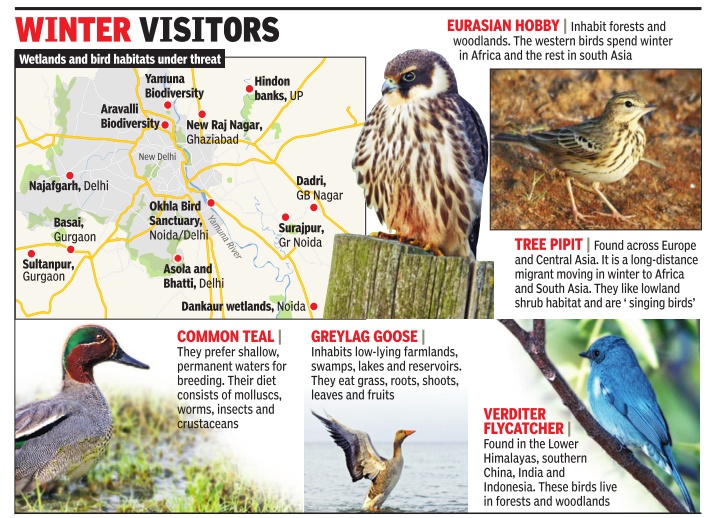
Foreigners are chirping around city
Proof that winter has arrived lies not just in the nippy mornings but in the sights and sounds of a variety of migratory birds that flock to the NCR every year. If you visit the capital's wooded areas, chances are you will be treated to the lark's or tree pipit's sweet song or may even manage to catch a glimpse of the magnificent Verditer flycatcher. Over the past week, a variety of migratory species riety of migratory species have arrived in the city, however, their numbers are not very big. “The reason for this is the warm climate. The common arrivals include the Black-tailed godwit, sandpipers, wagtails and warblers.I also spotted a Steppe eagle recently. Basai wetland in Gurgaon already has a lot of variety,“ said birder Nikhil Devasar.
At Aravalli Biodiversity Park, colourful terrestrial migratory species have become photographers' delight.“We have seen fewer whitethroats, Eurasian hobby , Black redstarts, blue-tailed bee eaters, Verditer flycatchers, shrikes and Singing tree pipits. We are still waiting for the thrushes. They are largebodied birds that like a lot of litter of dry leaves, sticks, grasses and shrubs on the ground. Thrushes are very important because they signify that the forest cover is good and intact,“ said Aisha Sultana, a field biologist at the park.
Birders said Mangar area along the Gurgaon-Faridabad highway and Asola Bhat ti sanctuary are also teeming with birds.
Suresh C Sharma and his friends spotted more than a hundred Graylag geese at the Bhindawas bird sanctuary in Haryana on Wednesday .“It's a very large number so I am optimistic about this year. I also saw more than eleven species of raptors like the Short-toed eagle, Crested serpent eagle, Common buzzard, etc,“ said Sharma, who also spotted water birds like pintails, shovelers and common teals.
Yamuna Biodiversity Park shows you how birds would have flocked to the river in its glory days. Scientists here have already spotted more than 200 Great cormorants and coots, about 20 to 30 Tufted ducks and four Common pochards.
“The river doesn't see these kind of biodiveristy anymore. I have seen some Ruddy Shelducks but that too only in the upper stretches the river. Ducks like phyto and zoo plankton are plantivorous so it's important that our water bodies have that vegetation,“ said Faiyaz A Khudsar, scientist in charge at the park.
A guide at Sultanpur bird sanctuary, Sanjay Sharma, said they are already flooded with visitors. “I think we have the highest numbers. About 15 species of water fowls and 15-20 species of woodland birds have arrived.“
2016
2016, summer: 188 species in Delhi, NCR
The Times of India, May 17 2016
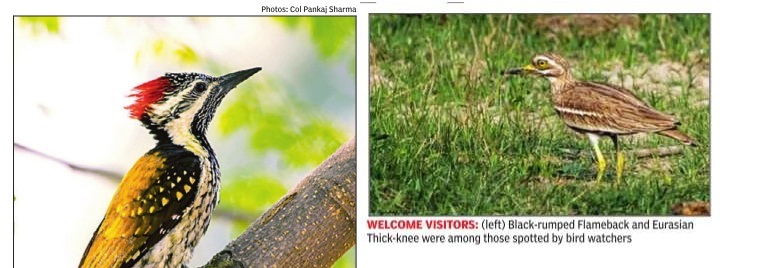
Summer bird count throws up a pleasant surprise
Neha Lalchandani
The first ever summer bird count in Delhi threw up some welcome results. Those who stepped out for birding on Saturday reported 188 species from across Delhi and NCR, “an encouraging sign“ since the winter count, when migratory bird numbers are substantially more, is between 240 to 250 species.
K B Singh, a birder who led one of the 15 teams, said that the data collected on Saturday provided important information on sites of breeding birds in Delhi and NCR. “Delhi summer bird count was an entirely voluntary initiative by the birdwatchers of the capital.The region has a very rich birdlife, including resident birds that breed here, local migrants, summer breeding visitors and winter migrants that arrive with the onset of colder season. All observers contributed their sightings and records to eBird, an online database of bird observations. Despite the torrid summer heat, the team led by veteran birder Suresh Sharma recorded over 110 species from near Sonipat. Importantly , there were five teams with a tally of over 100 species recorded during the course of the morning birding,“ he said.
The summer count shows that despite massive pressure on habitats, Delhi remains rich in resident birdlife. Birders report that 95 resident species were seen fairly commonly across the city . In addition, over 40 species of birds were easily sighted in the appropriate habitats. Another 15 resident species, considered uncommon or rare for the region, were also reported, including White-bellied drongo, Crested bunting, Black-headed cuckoo-shrike, Indian pitta, Red-headed vulture, Painted sandgrouse, Oriental pratincole, Dusky eagle owl, Indian courser, Black-necked stork and various crakes.
“Most of these species occur in the ridge or on Yamuna flood plains, highlighting their role as important bird habitats,“ said Singh.
Of the 152 resident species, there were 32 endemic species -birds seen only in India. Interestingly , 36 species of win ter migrants were also found lingering in the region despite the high temperatures.
Singh said suitable habitats were largely responsible for the good number of species observed. For instance, he said, Yamuna and its flood plains are the richest in terms of avian biodiversity. A team led by Sunil Kumar, which covered the area, reported over 110 species from this riverine belt.The reed beds of the flood plains and the sand dunes are important for Black-bellied terns, Indian skimmer, Great thick-knee, White-tailed stonechat etc.
The Najafgarh drain and adjoining low lying areas, including the nearby wetlands of Basai and Sultanpur, are also important birding habitats.“Dry stony habitats of the ridge like Asola, Sanjay Van, Delhi Cantt, Rajokri, Mangar, Damdama, Faridabad, etc look deceptively barren but are important habitats for many of endemic and endangered birds like Painted sandgrouse, Rufous-fronted prinia, Indian pitta, Jungle prinia etc. Important wetlands in the adjoining districts of UP and Haryana like Dhanauri, Dadri, Surajpur, Bhindawas, Dighal and Sonipat are under tremendous pressure from urbanisation but continue to be important birding habitats,“ said Singh.
2016, Winter
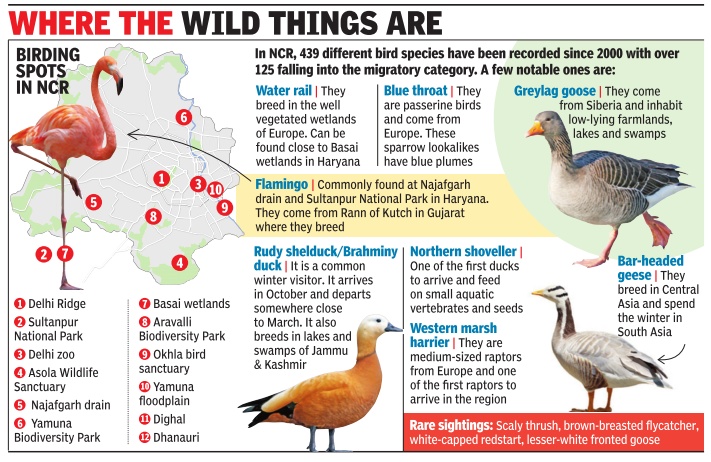
The Times of India, December 19, 2016
A sight to behold: Winged visitors arrive in droves
Jasjeev Gandhiok With winter having set in and temperatures dropping, flocks of migratory birds, some from as far away as Africa and Europe started arriving in the capital.
Birders across NCR have already made a number of rare sightings, including a scaly thrush and a brownbreasted flycatcher spotted near Mangar Bani, a lesser white-fronted goose at Dighal, and a white-capped redstart near Sonipat.
Birder Anand Arya who had spotted the lesser whitefronted goose last year said it was again sighted at Dighal, Haryana, in November.“Even though the bird has been spotted twice now, it is still a rare sighting,“ he said.
There are no records of a scaly thrush ever being sigh scaly thrush ever being sighted in NCR. Experts feel it may have strayed from its path. “The bird is usually fo und in the foothills of the Himalayas or near Odisha. We are still trying to figure out how it may have ended up here. It will be interesting to see if it is taking a break or will be spending the winter here,“ said birder Pankaj Gupta, who spotted the bird near Mangar Bani.
Birder and zoologist Surya Prakash said spotting the lesser white-fronted goose at Dighal and a scaly thrush near Mangar Bani are good signs for the aquatic ecosystem.
“It is likely that these birds were spotted as village ponds and other waterbodies were full this year due to a better monsoon,“ explained ornithologist Bikram Grewal.
More birds are visiting NCR this winter as compared to last year. “It has been a good winter so far in terms of migratory birds sighting,“ said Prakash.
Other rare sighting include the common buzzard and the oriental pratincole near the Yamuna, a brown shrike in Najafgarh and the largetailed nightjar near Mangar village. Among common migratory birds that have arrived in large numbers are northern pintails, common teals, northern shovellers, gadwalls, Eurasian coots, red-crested pochards and bar-headed geese.
Grewal and other birders spotted a pair of Eurasian bittern last week, a European bird seen in the region every few years. The ornithologist feels few species have been spotted in Okhla Bird Sanctuary this year as most birds seem to prefer other areas such as the Najafgarh drain and Dighal.
Another popular area for birders this year has been Dhanauri in Greater Noida.Around 25,000 birds have arrived at the wetlands there. It is also a good place to spot sarus cranes. Even Surajpur has attracted a lot of birds in 2016.
Racket-tailed drongo
2016: Sighted after 41years
The Times of India, Jul 03 2016
Jasjeev Gandhiok Bird lovers and wildlife enthusiasts in the city are thrilled at the discovery of a Racket-tailed drongo which has been sighted after 41years.The bird was seen at Sunder Nursery , a heritage garden which is known to attract a number of migratory birds. “I have been coming to the Sunder Nursery for years, but I have never seen a racket-tailed drongo here before. I was extremely surprised as they are usually found in thick forests and hilly areas,“ said wildlife photographer Vinod Goel. This bird has a unique characteristic of mimicking the sound of other birds in the wild, which helps it catch its prey . The bird was last sighted in the city in 1975, with unconfirmed sightings reported in 1991. “While the black drongo is common in Delhi, the racket tailed-drongo is much rarer.This particular bird mimics other birds in the area, particularly raptors. It deters them by mimicking their call and then swoops in on its prey ,“ said Faiyaz A Khudsar, scientistincharge at the Yamuna Biodiversity Park.
According to Bikram Grewal, author of several bird books, it is a significant sighting.“It's a good sign for Delhi, especially bird lovers who should keep a lookout in the area. The sighting is unusual, as the species hasn't been spotted in decades. The breeding season is also going on,“ Grewal said.
Eurasian bittern
Sighted in 2016 after 2002
Sharmila Bhowmick, Eurasian bittern spotted in 2016 after 2002, Dec 27, 2016: The Times of India
It was last seen in the marshes of Okhla Bird Sanctuary in 2002, as per written records of the birding community . The Eurasian bittern has been sighted again in the NCR this year, during the Christmas weekend. Birders are now pleasantly surprised as the rare heron has visited these parts after 14 years.
The Eurasian bittern or great bittern (Botaurus stellaris) is a wading bird in the bittern sub-family of herons. It is considered as an endangered bird species.
“This is most unusual. We went to Dhanauri wetlands during the weekend, and suddenly this bird appeared from behind bushes. We made photographic records and informed all birder groups. It is indeed important news for the birding community,“ Mudit Bhatnagar, a senior member of the Delhi Bird Photographers group, said.The group is a community of birders who regularly spot, photograph and document birds in their habitats in the wetlands of Delhi, Noida, Greater Noida and Gurgaon.They maintain a year-long calendar of birding events. In NCR, over 100 birders regularly go on photo-walks in small groups to explore and spot birds.
“Bird watching is gaining popularity as a hobby and passion. Spotting birds is closely related to photography as well, and we find a lot of enthusiasm in the participants of our community every weekend,“ Mathew Joseph, founder, Delhi Bird Photographers group, said. The group, founded by Joseph two years ago, has so far done 150 photo walks in Noida and Greater Noida's wetlands, Okhla Bird Sanctuary and in Gurgaon. “Apart from the bittern, birders also spotted Bonelli's Eagle, Greater Spotted Eagle, Marsh Harrier, Black Shouldered Kite, Sarus Crane, Painted Stork, Spoonbill and Common Greenshank, during the weekend at Dhanauri,“ said Maneet Pal Singh, who also spotted the bittern along with other birders during the weekend. Dhanauri wetland, popular for huge numbers of Sarus, is increasingly becoming an important birding destination.Migratory as well as domestic birds are shifting to the greener, less congested interiors and rural ends, as habitats for nesting and roosting.
Song Thrush and Brown Hawk Owl
Jasjeev Gandhiok, Rare winged visitors thrilled birders in 2016, Jan 1, 2017: The Times of India
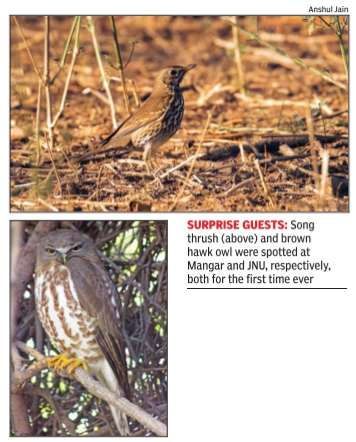
It was a successful year for ornithologists and birders in the National Capital Region after a number of rare species were sighted in the region. In Delhi particularly, species like the song thrush and the brown hawk owl were spotted at Mangar and Jawaharlal Nehru University, respectively, both for the first time ever.
In addition, sightings of ra re and vagrant species like scaly dark throated thrush, orange headed thrush, white capped water redstart and Marshall's Iora were reported in NCR through the year. For bird enthusiasts, the Dhanauri wetlands and Mangar remained the most favourable birding hot spots with most sightings of new and rare bird, including the great bittern, taking place there.
“A song thrush is a rare bird for India, let alone Delhi, and this year was the first time it was sighted in the capital,“ said birder Kanwar B Singh.“Also recorded for the first time within Delhi was the brown hark owl, usually only seen on the periphery of NCR.“ Experts, however, said that the reason for such sightings was not because Delhi's habitat was improving, but because more people were now getting involved in the hobby of bird watching.
As Dr Surya Prakash, zoologist and ardent bird watcher, pointed out, “More people are now focusing on birds and are fully loaded with the technology and equipment required for bird watching. Also, a number of small groups have been monitoring specific areas on a regular basis and reporting sightings to others through e-groups. That has helped us find and spot more birds.“
Sultanpur National Park and Okhla Bird Sanctuary were other hot spots for ornithologists, with species like Whistler's warbler, blue capped rock thrush, brown breas ted flycatcher and orange breasted pigeon being spotted there. Other rare species like the forest wagtail, pallid scops owl, griffon vulture and oriental pied hornbill were also observed there.
The Asola Bhatti area proved beneficial with a grey winged black bird and a large cuckoo shrike seen there, while the Yamuna Biodiversity Park's Phase II reported the sightings of Stoliczka's bushchat and grey headed lapwing.There was photo documentation of two new woodpeckers from Aravalli this year: the streaked woodpecker from Asola and the brown capped pigmy woodpecker from Mangar. In addition, reportings were also made within Delhi of a greater racket tailed drongo at Sunder Nursery and a great pied hornbill at Greater Kailash.
2017
2017, Big Bird Day: 268 Species Spotted
Jasjeev Gandhiok, Birders thrilled with more sightings this yr, Feb 10, 2017: The Times of India
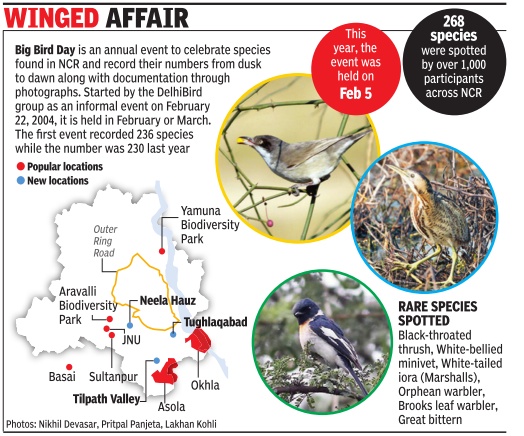
268 Species Spotted On Big Bird Day In 2017
Good monsoon and an abundance of food across wetlands in Delhi and its neighbouring areas made it a fruitful year for birders, with more species being spotted than last year. The results of the Big Bird Day , an annual event aimed to record bird species found across the country , were released on Thursday . According to them, 268 species were recorded this year, up from 228 in 2016.
The event was conducted on Feburary 5 by the DelhiBird group and over 40 groups participated, each comprising close to 25 birders.Schoolchildren also took part in this year's count.“The response this year has been very good. Over 1,000 birders participated and we chose some new locations like Neela Hauz, Tughlakabad and Tilpath Valley for bird counting. More diversity was seen this year, along with many rare sightings, as the wetlands across the NCR are still full of water. A good monsoon has certainly helped and there is a lot of food for these birds,“ said Nikhil Devasar, organiser of the Big Bird Day . According to Devasar, a number of rare sightings were also made this year, which included birds like the Great bittern and Water rail in Dhanauri; a White-bellied minivet and White-tailed iora near Sohna; and a Blackthroated thrush in Dighal.An Orphean warbler and a Brooks leaf warbler were also spotted this year. “More birders are coming out, which means more eyes are there to spot these birds. We also participate in birding activities every Sunday and encourage people to join in and learn,“ Devasar added.
A total of 103 species were seen at Yamuna Biodiversity Park this year as compared to 91 last year. The rare sightings included orange headed thrush and a white-tailed lapwing. Kamla Nehru Ridge recorded 55 species this year, including a red-throated flycatcher. Tughlakabad Biodiversity Park, where this event took place recorded 26 species, including a steppe eagle sighting.
“A Marshall's Iora and a brooks leaf warbler were spotted by our group at Mangar forest, where we spent a lot of time before heading to Aravalli Biodiversity Park. The findings have been particularly fruitful this year,“ said birder Pankaj Gupta.
Bird census/ February 2017
Jasjeev Gandhiok, 39 new bird species flock to census list , March 12, 2017: The Times of India
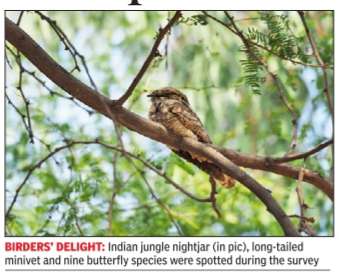
Ahead of plans to open seven city forests for the public, department of forest and wildlife conducted a bird and butterfly census last month at the Mitraon city forest.
The census revealed 39 different species, including rare sightings like the Indian jungle nightjar, long-tailed minivet and nine butterfly species.
The department has now plans to conduct several surveys at city forests like Garhi mandu, Issapur, Bela farm, Shastri Park and Alipur to determine the kind of habitat it has to attract birds. “We had a successful census at Mitraon where 10 acres has already been opened for the public. Now we will conduct a census next at Isapur. These will give us an indication of the habitat there so that we can prepare accordingly ,“ said a senior forest officer.
Sohail Madan, centre manager, BNHS (Asola) said that the preliminary survey reports were very promising. “This urban forest holds a great diversity of birds and butterflies, which is a boon for the residents.The highlight of the survey was an Indian jungle nigh tjar, which is a nocturnal bird and is extremely elusive for Delhi. Apart from that, we have spotted small minivets and long-tailed minivets, which are endemic to this part of the city ,“ he added.
The census also recorded a red-breasted flycatcher, a golden flameback woodpecker, two types of raptors, including a shikra and eight spotted owlets among others. The butterflies found included the cabbage butterfly and the common emigrant.
Forest officials said that the next census might begin by the end of this month, with modifications made to the city forests based on the findings.
Egyptian vulture (Neophron percnopterus)/ 2017
Endangered Egyptian vulture rescued from E Delhi temple, November 30, 2017: The Times of India
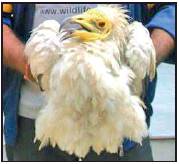
From: Endangered Egyptian vulture rescued from E Delhi temple, November 30, 2017: The Times of India
An endangered Egyptian vulture found injured in a temple complex in Patparganj, east Delhi, was rescued.
The bird was discovered by a priest who informed NGO Wildlife SOS, which sent a team of handlers to the temple. Egyptian vulture (Neophron percnopterus) also called the white scavenger vulture or pharaoh’s chicken is the smallest among all vultures. It is identified as globally endangered on the International Union for Conservation of Nature (IUCN) red list. The NGO said this is the second time an Egyptian vulture has been rescued this year.
“It is rarely spotted in Delhi but in recent years, there have been sightings near Yamuna Biodiversity Park and Okhla Bird Sanctuary. Their population is decreasing because of factors like loss of prey base and habitat, poisoning from veterinary drugs and even electrocution,” said Kartick Satyanarayan, co-founder, Wildlife SOS.
The bird will be kept under observation for the next few days and will only be released in the wild when it has completely recovered, officials said.
2017, Dec.: winter sightings
See graphic:
Birds sighted in Delhi in December 2017, region-wise
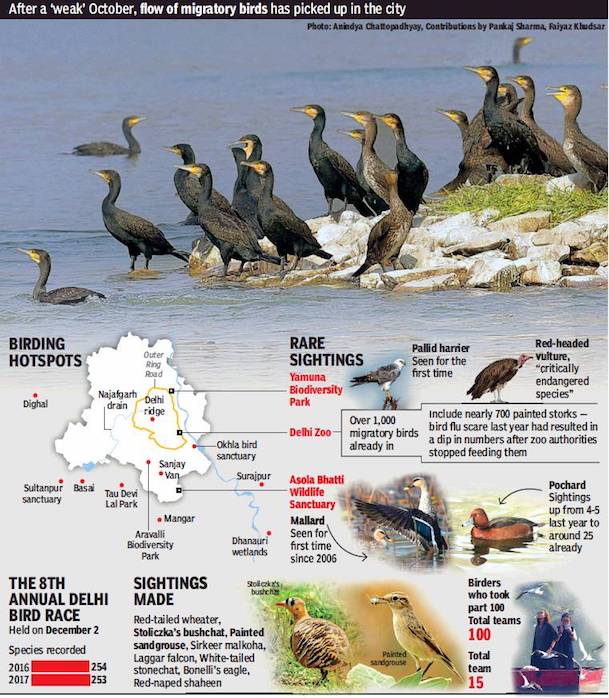
From December 11, 2017: The Times of India
2018
2018: lesser number of migratory birds
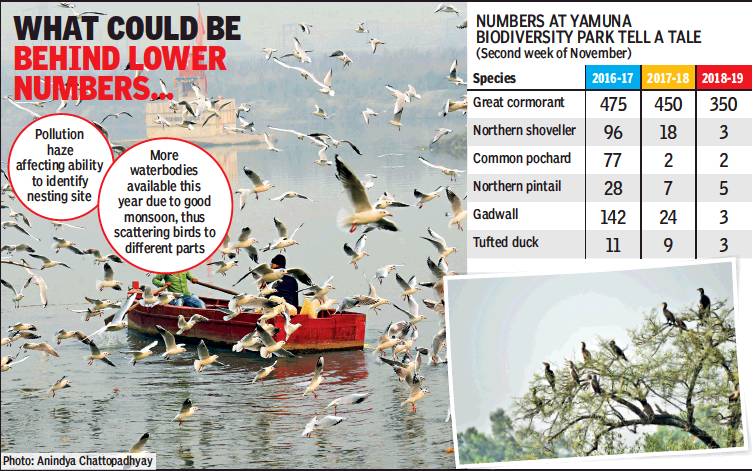
From: Jasjeev Gandhiok, Many winter guests skip flying visit to city, November 13, 2018: The Times of India
High pollution levels in the national capital region seem to be a cause of concern not just for its residents but also for its winged guests in the winter. Compared to the same period last year, the number of migratory birds has come down at most locations in 2018, probably due to the haze surrounding parts of NCR, said birders and ornithologists in the region.
Experts said new birding hotspots had been found this season near Rohtak in Haryana, possibly because of availability of large waterbodies and cleaner air.
Sohail Madan, centre manager at Asola Bhatti Wildlife Sanctuary, said an early migration was observed this year but the numbers had dried up since then. “The winter came slightly early this time and an extended rain spell saw migratory birds arriving even a month earlier than normal. However, the overall count at this moment seems less than normal and pollution could be forcing certain species to fly elsewhere,” said Madan of Bombay Natural History Society (BNHS).
According to Anand Arya, a veteran birder, a good monsoon this season is also “scattering” birds in different locations due to availability of more water. “We are seeing large numbers particularly in Haryana,” said Arya, adding that Dhanauri in Haryana’s Jind has recorded almost 10,000 species.
“The numbers have been slightly low and this is because the pollution in NCR has been extremely high. The temperatures in the Indo-gangetic plains have also not gone down enough and once the temperatures drop in the upper reaches, you could see an influx once again in the next 10 days or so,” he added.
The dip has also been evident at Yamuna Biodiversity Park where sightings are often recorded for each week. The data collected for the second week of November shows a sharp decline in the species being sighted as compared to both 2017 and 2016. The park has recorded around 350 great cormorants by the second week of this November compared to 450 in 2017 and 475 in 2016. Similarly, only three northern shovellers have been recorded this time against 18 in 2017, which itself was a huge drop from 96 in 2016.
The same can be said about common pochards — only two have been seen this year against 21 in 2017 and 77 in 2016. The park has also recorded arrival of five northern pintails compared to seven in 2017 and 28 in 2016, and that of three gadwalls against 24 in 2017 and 142 in 2016.
“We have seen a sharp drop in numbers compared to 2016 and a slight drop against last year’s counts. The pollution and the resultant haze could be affecting them. We have seen shovellers do a recce of the waterbody but they did not return after that and may have proceeded to parts of Haryana,” said Faiyaz Khudsar, scientist incharge at the park. During winter, pollutants get trapped, making it difficult for the birds to identify their sites, he added.
Jaswinder Waraich, another birder, said locations like Okhla, Yamuna Khadar and Dhanauri had recorded a drop, but some are reporting good sightings. “They have taken time to arrive and the numbers are slowly picking up in NCR,” said Waraich.
2017>2018: drop in number of bird species (268 to 238)
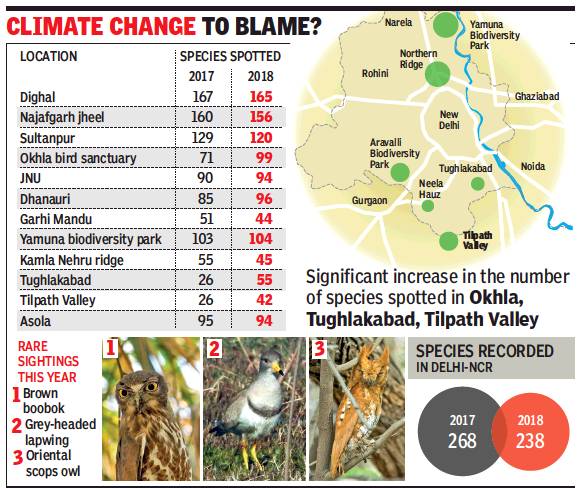
From: Jasjeev Gandhiok, Big Bird Day records number of bird species down to 238 from 268, March 5, 2018: The Times of India
NCR has recorded a drop in overall bird species on the Big Bird Day — an annual birding event across the region where birders set out to record different species with 238 species counted this year as compared to 268 in 2017. Bird species across different locations in the capital also recorded a slight drop compared to last year, however there has been significant increases in locations like Tughlakabad, Tilpath Valley and Okhla bird sanctuary when compared to data from last year.
The important sightings recorded this year included the oriental scops owl — last seen in 2011on the outskirts of NCR and extremely rare for the region; a brown-hawk owl which was sighted at Asola and a pair of grey-headed lapwing at the Yamuna Biodiversity Park. “We are studying if the migratory owl species have become residents in the capital or not,” said Dr Surya Prakash, zoologist, JNU.
Birders across the region feel the overall drop in numbers could be due local climate change which may be affecting the migratory pattern of certain species, forcing them to leave early. “By this time last year, a lot of the species hadn’t left but this time temperatures have been very high and a few species have left. There has been little rainfall this winter and the temperature has been warmer than normal which could have resulted in this drop,” said Nikhil Devasar, organiser of the event.
According to the results, bird species almost doubled at Tughlakabad this year, increasing from 26 last year to 55 this time around while Tilpath Valley recorded 42 species this year as compared to 26 last year.
Faiyaz Khudsar, scientist in-charge at the Yamuna Biodiversity Park, said the increase at these locations could be due to better protection. “Grazing at Tilpath and Tughlakabad was reduced this year which has protected the scrublands and resulted in an increase in insect and invertebrate diversity. This in turn attracts more bird species to the area,” he said.
Okhla also recorded a significant improvement with 99 species recorded this time around as compared to 71 last year. Team captain Jaswinder Waraich said the increase could be attributed to careful scanning of the area and increased available of food this year. “The important sightings at Okhla this year included booted eagle, mallards, grey bushchat and greater spotted eagle,” said Waraich.
2017>2019: 50% drop
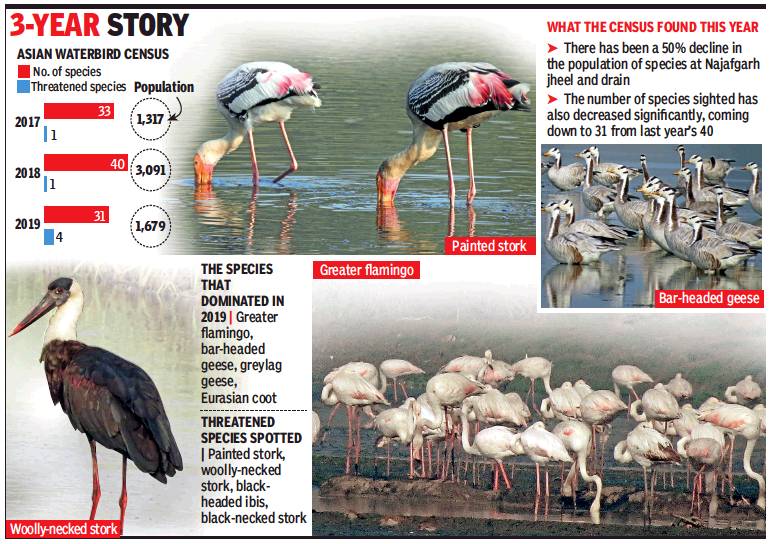
From: Jasjeev Gandhiok, Climate change? 50% dip in winged visitors at Najafgarh, January 17, 2019: The Times of India
The migratory bird count at Najafgarh jheel and drain fell nearly 50% compared with the same period last year, the Asian Waterbird Census 2019 has revealed.
According to T K Roy, state coordinator of AWC in NCR, there has been a significant drop in the number of species and birds recorded this year compared with AWC 2018. Only 1,679 birds have been sighted this time around against last year’s 3,091. The number of species has also gone down to 31 against 40 last year. “Despite good rain, we are seeing lower number of birds this year. The diversity in terms of species has also come down. However, four species, which are on the IUCN-threatened list, were recorded during the count this year,” Roy said.
The IUCN-threatened species that have been recorded are painted stork, woollynecked stork, black-headed ibis and black-necked stork, Roy said. Each census is carried out by a team of volunteers that gets divided into smaller groups to cover the entire wetland. Roy says two to three groups were formed for the count on Wednesday. International protocol for the census was followed to directly identify and note down each species before collectively looking at larger numbers for the population. Photography was also used to identify birds, he added.
Roy said climate change and other factors were disturbing the migratory pattern of certain species. “With migratory waterbirds arriving from Central Asia, Northern Asia and other parts of the globe, the species diversity and total number tends to fluctuate. It either increases or decreases and early or late migration is recorded across the country year by year. Interestingly, Indian migratory bird greater flamingo is a resident bird on this wetland throughout the year now,” Roy said.
Other birders however said the numbers seemed low for this time of the year, but NCR has showed a significant improvement in January. “The numbers seem low and the species count should also be much higher. While almost all locations were recording low numbers in December, this has gone up considerably, including at Najafgarh in January due to low temperature affecting the locations these birds come from,” said Anand Arya, a birder.
Kanwar B Singh said there is nothing to worry as Najafgarh is doing well this year, while Nikhil Devasar said a recent visit to Najafgarh revealed a high count of species, including rare ones like great bittern and water pipit. “We visited this Sunday and recorded 111species. The methodology of the census may vary, but in general, we have captured some rare species as well which is a good sign and Najafgarh seems to be doing well,” said Devasar.
AWC is the largest waterbird census in Asia and is done with the help of Wetlands International – a global wetland conservation organisation across 27 other countries.
Water birds double from 2017
Jasjeev Gandhiok, Waterbird census on, numbers double in 2018, January 14, 2018: The Times of India
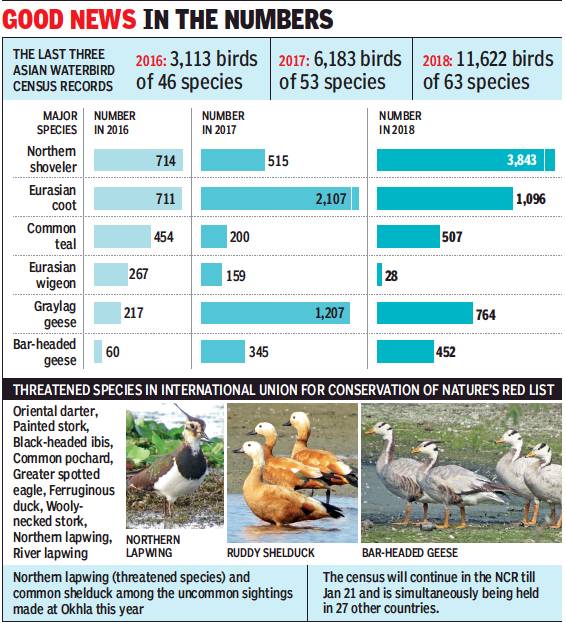
Threatened species
From: Jasjeev Gandhiok, Waterbird census on, numbers double in 2018, January 14, 2018: The Times of India
See graphic:
Water birds in Delhi, 2016-18;
Threatened species
With the Asian Waterbird Census (AWC) 2018 currently underway in Delhi-NCR, the findings of the first few days at Okhla Bird Sanctuary have revealed that the bird count has almost doubled since 2017. There has also been an increase in the number of species at the sanctuary.
This year’s count at Okhla Bird Sanctuary revealed 11,622 water birds as compared to 6,183 birds, which were recorded last year. In addition, the number of different species has also risen to 63 as compared to 53 in 2017. These include nine species that fall under the IUCN red-list of threatened species.
The Okhla Bird Sanctuary is one of the 466 Important Bird Area sites located in India. The census was carried out by Wetlands International South Asia, in collaboration with Gautam Buddh Nagar Forest Division, and a team of 30 members from different universities and Bombay Natural History Society.
AWC Delhi state-coordinator and ecologist TK Roy said that the census has also revealed sighting of two uncommon species at the sanctuary this year — the northern lapwing and the common shelduck.
“This a good sign for the ecology of the area. Both birds are not very common to the area. In fact, the northern lapwing has been sighted in India after several years. The count of species has also risen this year and there has been a steady growth in the numbers over the past two years. This shows that there has been a revival at Okhla,” Roy told TOI.
In 2016, 3,113 birds were recorded at Okhla, which consisted of 46 different species. The same number has increased to 11,622 this year, consisting of 63 different species. The oriental darter, painted stork, black-headed Ibis, common pochard, greater spotted eagle, ferruginous duck, wooly-necked stork, northern lapwing and the river lapwing are among the IUCN red-list threatened species sighted at Okhla this year.
Roy attributed the considerable increase in number of bird count to more northern shovellers arriving at Okhla in 2017, along with a mixed flock of black-headed and brown-headed gulls.
“These birds would earlier spend their day around Yamuna and come to Okhla at night. This year, however, they are staying at Okhla all day. This has resulted in an increase in the overall count of birds,” Roy added.
The numbers could have been even more, Roy said, but for the repair work at Okhla barrage in October, which saw a number of waders leave the sanctuary.
The census, which will continue till January 21, will also cover other locations like the Yamuna floodplains, Delhi zoo, Sanjay Lake, Najafgarh drain and Surajpur wetlands.
Number of birds documented: Big Bird Day 2018
Birders flock together to get a count, February 19, 2018: The Times of India
Hundreds of birders gathered at wetlands, forests and biodiversity parks of the capital to spot and document as many bird species as possible. They were participating in Big Bird Day 2018, an annual national event started by a birding group, Delhibird.
About 38 teams from Delhi-NCR participated in the event, each having 10-40 birders. The results, which will take a couple of days to be compiled, play a crucial role in documenting the number of birds and diversity in the country.
In all, more than 10,000 birders from across the country participated. In Delhi-NCR, birding sites like Dighal, Sultanpur, Basai, Asola, Najafgarh, Yamuna Khadar, Mangar Bani, Dhanauri, Dadri, Okhla Bird Sanctuary, Aravalis, Yamuna Biodiversity Park etc were explored. “It’s very difficult to give the trends right away. We haven’t got any reports of exceptional sightings from Delhi-NCR yet,” said Nikhil Devasar, one of the organisers who spent a part of the day at Dighal.
Yamuna Biodiversity Park recorded 104 species this year as compared with 103 last year. Rare sightings included the Grey-headed lapwing, Ferruginous pochard, mallard, Red-crested pochard and garganey. “The Grey-headed lapwing is an important sighting and we have been seeing for two weeks now. It is a rare bird for Delhi...the count also helps us to know the right habitat and environment. A high count of birds means that the habitat is thriving,” said Faiyaz A Khudsar, scientist in charge, Yamuna Biodiversity Park.
At Kamla Nehru Ridge, the number of species spotted went down to 45 this year from 55 in 2017. Woodshrike and White-eared bulbul were the rare sightings in the area.
However, numbers at Tughlakabad Biodiversity Park and Tilpath Valley rose significantly this year to 52 and 43 species recorded respectively as compared with just 26 species at each of the locations last year.
The sightings at these locations included a Sirkeer malkoha, common woodshrike, Yellow wattled lapwing and Yellow-eyed babbler, among others.
M Shah Hussain, scientist in charge at Aravalli Biodiversity Park said, “A total of 900 birds of 79 species were spotted during the count period. Important bird species that were seen in Aravalli Biodiversity Park included Jungle bush quail, Eurasian eagle owl and Oriental skylark”.
He added, “Tufted duck was also sighted at Neela Hauz Biodiversity Park after its restoration. The highlights, Jungle bush quail and Eurasian eagle owl, are rare for south Delhi”.
Only 594 waterbirds seen
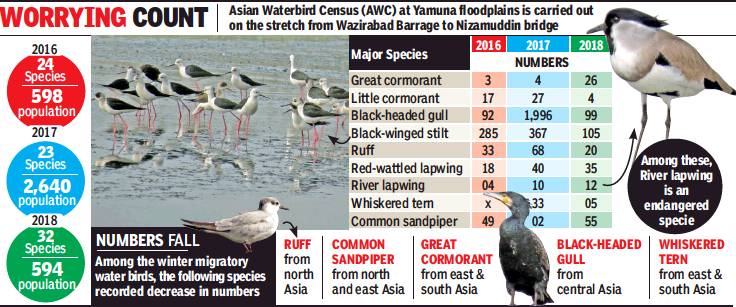
From: Jasjeev Gandhiok, Hope flies away as only 594 waterbirds seen in 2018, January 21, 2018: The Times of India
Sharp Fall In Numbers Over Last Year At Yamuna Floodplains
The population of waterbirds in the Yamuna floodplains has gone down considerably this year, though the number of species sighted rose from last year’s 23 to 32 this time around, the latest findings of the Asian Waterbird Census (AWC) 2018 have shown.
The number of water and water dependant birds were recorded at 594 this year – a sharp drop from the 2,640 birds last year, which experts attribute to human interference on the floodplains, climate change and pollution.
“Due to global climate change, shrinking wetland habitats and changing trends of long distant winter migratory birds, there has been a reduction in the numbers at Yamuna. Last year, the majority of these numbers consisted of black-headed gulls, which have now gone to Okhla this year,” AWC state coordinator TK Roy toldTOI.
The census, which is simultaneously being conducted across 27 countries, was conducted at Yamuna floodplains between Wazirabad barrage and the Nizamuddin bridge on January 13, by volunteers from several universities, Greenpeace, experienced birders from Delhi and the AWC Delhi state coordinator and ecologist, TK Roy.
Last year’s census recorded 1,996 black-headed gulls at the Yamuna floodplains, however these numbers fell to just 99 this year. Among the other birds which fell in numbers was the common sandpiper, great cormorant, whiskered tern and ruff.
Roy said that out of the 32 species, only the river lapwing is classified as threatened according to the IUCN red list, which rose from 10 last year to 12 this time. The count identified 13 species from the 32 as resident water birds, with the remaining 19 as winter migratory birds. The AWC in 2016 had recorded 24 species with 598 birds in total.
The AWC began on January 6 in Delhi and will continue till January 21. Among the areas covered include the Okhla Bird Sanctuary, Najafgarh drain, Yamuna floodplains, Delhi zoo, Sanjay Lake and Surajpur wetlands. Findings at Okhla last week had shown that the number of birds has almost doubled this year, increasing from 6,183 birds in 2017 to 11,622 birds this year. Roy said the final phase of the census is currently underway at Delhi zoo, with the results likely to be out in the next few days.
Summer 2018/ 174 species recorded
Jasjeev Gandhiok, Flying high: Birders record 174 species, May 31, 2018: The Times of India
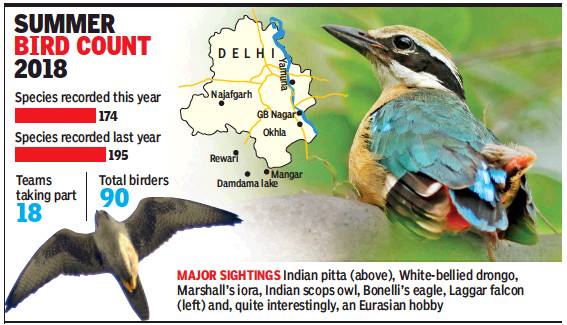
From: Jasjeev Gandhiok, Flying high: Birders record 174 species, May 31, 2018: The Times of India
It was a fruitful morning for birders as 18 different teams set out across different parts of Delhi NCR for the 3rd annual edition of the summer bird count, results of which came out. A total of 174 species were recorded in 2018– a sharp drop from the 195 species which were recorded in 2017. However birders attributed this to an early summer and the fact that the count was organised by the end of May instead of early May, so no “winter migrants” were recorded.
“In the previous years, the summer bird count was held in early May and we usually had 35-40 lingering winter migrants making it to our total species count. To avoid that, we have held the count much later this year and therefore we’ve seen a drop in the number. As a result only 10 lingering migrants were recorded,” said Kanwar B Singh, a birder and organiser of the event.
Singh said that 90 birders took part this time, including two teams consisting only of children. A team led by Brigadier Arvind Yadav covered the bird habitats along the Najafgarh drain, with a total of 108 different species recorded there, including the oriental pratincole that breed there during the summer months. The team also managed to sight a ruddy-breasted crake – an uncommon bird usually found in the reedbeds.
At the Yamuna floodplains, a total of 90 species were recorded which included summer breeding residents like little tern, cotton pygmygoose, white-tailed stonechat and river lapwing among others. For the first time in the count, the neighbouring district of Rewari was also covered with a team led by Dr Parikshit Yadav recording 103 species. A number of uncommon and important sightings were also made in Mangar and Damdama lake which included the sighting of the Indian pitta – a breeding visitor to forest patches in the area.
2018: Rare migratory bird spotted at Aravali park
Shilpy Arora, Rare migratory bird spotted at Aravali park, August 27, 2018: The Times of India
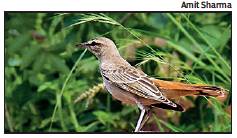
From: Shilpy Arora, Rare migratory bird spotted at Aravali park, August 27, 2018: The Times of India
August 26 morningbrought cheer to the community of birders in Delhi-NCR, after a rare migratory bird, the Rufous-tailed Scrub Robin, was sighted at the Aravali Biodiversity Park.
The bird was spotted for the first time in the Aravali Biodiversity Park last year. According to birders, sightings during the same time of the year (for two consecutive years) might indicate the bird has made Gurgaon its monsoon migratory destination.
“Last year, during the same time, I saw a Rufous-tailed Scrub Robin in the Aravali Biodiversity Park of Gurgaon. The entire birder community was taken by surprise, as this was probably the second or third record of a sighting from our zone. Last year, we considered this as an accidental record, as sometimes the bird stops en route during migration. However, this year we have again spotted the bird in the same month. This gives us hope that Aravali Biodiversity Park habitat is inviting the bird, and that Gurgaon could be its monsoon migration destination,” said Amit Sharma, an avid birder who spotted the bird along with two other enthusiasts, Gaurav Yadav and Janardan Barthwal.
Birder Gaurav Yadav, from DLF Phase 4, said, “I have been birding for the last two years. It’s very rare that one sees a Rufous-tailed Scrub Robin here.”
As per birders, the Aravali Biodiversity Park has done a great job in growing and maintaining native species of the Aravalis, which is now attracting birds. Pankaj Gupta of NGO Delhi Bird Foundation agreed, saying, “Native plantation in the Aravali Biodiversity Park is definitely paying off in protecting and inviting rare species. It provides a safe habitat to birds. Food is also in abundance.”
While the Rufous-tailed Scrub Robin has been recorded in scrub forests of Rajasthan and Gujarat, there are only 3-4 sighting records of the bird in the last 10 years in Delhi-NCR. Some 2-3 years ago, there were reports of the bird being sighted in Dadri and Surajpur areas of Noida. The bird is generally spotted in scrub forests and migrates from the Gulf region to India.
Vijay Dashmana, chief ecologist at the Aravali Biodiversity Park said, “The sighting shows that we need more city forests to conserve flora and fauna of the Aravalis.”
Rise in migratory bird count at Okhla
Sharmila Bhowmick, December 13, 2018: The Times of India
Okhla Bird Sanctuary, one of the largest destinations for migratory birds in the NCR, has recorded a 40% surge in its seasonal guests this year so far, as compared to the same period last winter.
Close to 7,000 birds from migratory categories — mainly comprising terrestrial birds, water birds and raptors — have been found in the sanctuary, during a counting done earlier this week. There were only about 5,000 birds during December 2017, revealed district forest officials.
“We are happy to see the rise in the number this year. There are multiple reasons for this. First, the water level at Okhla is good this year. Additionally, we prepared conservation efforts well ahead of the season, and created floating beds made of bamboos and leaves to make perching spots for birds to rest. Migratory birds have started flocking to these beds and we have been able to retain more birds this year than last year,” Gautam Budh Nagar district forest officer PK Srivastava told TOI.
The migratory season at the Okhla sanctuary starts by October and lasts until the end of March.
Currently, terrestrial winter birds, like bluethroat, common chiffchaff, verditer flycatcher, grey headed canary flycatcher, common stonechat, black redstart and lesser whitethroat, are camping at Okhla. These apart, raptors, namely peregrine falcon, Eurasian hobby, greater spotted eagle, serpent eagle, marsh harrier, are also seen in the sanctuary now.
2019
2019: slight decline in sightings
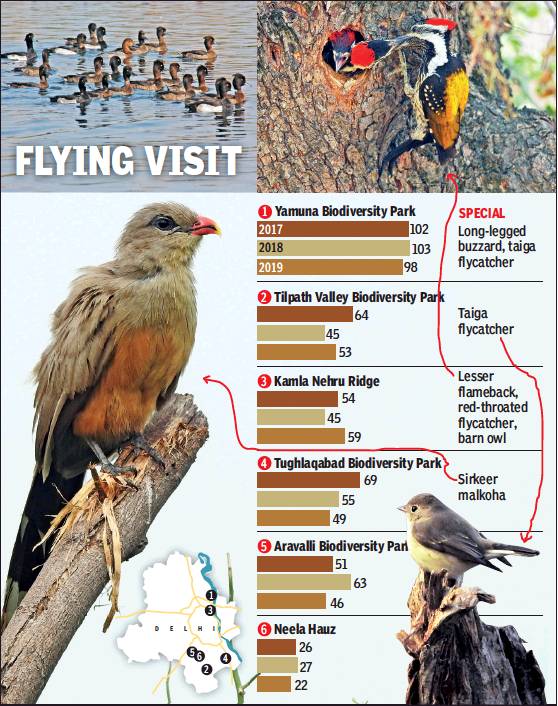
From: Ritam Halder, Delhi wakes up nice and early to keep date with winged visitors, February 4, 2019: The Times of India
INITIAL COUNT SUGGESTS SLIGHT DIP IN NUMBER OF SIGHTINGS
Birders and enthusiasts braved a foggy morning on Sunday to take part in the Big Bird Count 2019 and visited the green zones across Delhi-NCR to spot and count the number of winged visitors this season.
About 35 teams from Delhi visited the bird hotspots, like biodiversity parks, Basai Wetlands, Sultanpur, Kalesar National Park and Dighal, among others. Even though the final results of the count will be compiled in a few days, initial reports show a slight decrease in the number of birds as compared to the last two years.
“Some of the exciting spottings included greater whitefronted goose, which is rare in Najafgarh, brown shrike, peregrine falcons and steppe eagles. It was a bit foggy when we started at 8am, but it became fine an hour later. The overall numbers seem to be down, but it’s not alarming,” said Nikhil Devasar, founder of Delhibird and organiser of the event.
At Yamuna Biodiversity Park, 98 species were spotted, marginally less than last year’s 103. At Tughlaqabad Biodiversity Park, 49 species were recorded as compared to 55 in 2018 and 69 in 2017. Aravalli Biodiversity Park saw 46, much lesser than 63 in 2018, while 22 species were spotted at Neela Hauz, as compared to 27 in 2018.
Experts said the number is less owing to poor visibility due to heavy smog in the morning. “For example, at Yamuna Biodiversity Park, many birds were hiding in the grass due to fog. I spotted gadwall, a migratory species, in the grass,” said Faiyaz Khudsar, scientist in-charge at Yamuna Biodiversity Park.
At Tilpath Valley, however, the numbers have improved as 53 species were spotted, an improvement from last year’s 45. At Kamala Nehru Ridge, too, 59 species were spotted compared to 45 in 2018.
However, it was not just about numbers for the participants. Lipika Kapoor, a Gurgaon-based nutritionist, had a lovely morning. This first-timer can now boast of spotting multiple winged wonders at Aravalli Biodiversity Park. “I became interested in birding recently. It was an interesting experience. It helps that a group of passionate and knowledgeable people are here to guide you,” she added.
The first Big Bird Day was organised in February 2004 by Delhibird. The event was restricted to Delhi and birders recorded 236 species. In 2013, the Big Bird Day went national with over 160 teams, including over 1,000 birders, coming together to count the avian populace. In 2017, the event had six international teams, including those from Singapore and Dubai.
Slight increase in number of species
Jasjeev Gandhiok, Despite fog, birders find more species, February 11, 2019: The Times of India
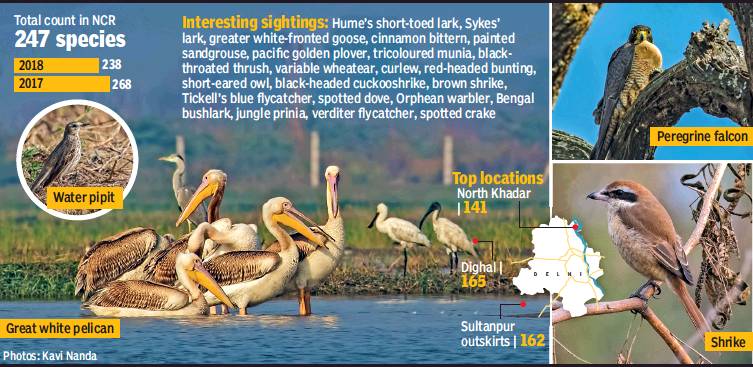
From: Jasjeev Gandhiok, Despite fog, birders find more species, February 11, 2019: The Times of India
There is reason to cheer for birders across NCR this year with the results of the Big Bird Day 2019 revealing a slight increase in the number of bird species as compared to last year. While the total count of species last year was 238, the number has swollen to 247 species this year with Dighal in NCR recording the highest diversity of species in terms of numbers.
“The response has been great this year. Wetlands across NCR saw low numbers initially in November and December, but most locations are flourishing now. Dighal recorded 165 species, the fourth highest in India,” said Nikhil Devasar, organiser of the event.
The team at Dighal was led by Maitreya Sukumar, while Sultanpur in Gurugram was the second highest in terms of species at 162 and led by birder Kavi Nanda. North Delhi’s Sunderpur had the third highest count with 141 species, led by team captain Akash Gulalia.
Over 35 teams took part in this year’s count, covering popular locations like Sultanpur, Dighal, Dhanauri, Asola Bhatti, Okhla, Yamuna Khadar and biodiversity parks. Devasar said for this first time ever, two teams – Dighal and Sultanpur — were also led by schoolchildren.
The important sightings made this year include Hume’s short-toed lark, Syke’s lark and Greater white-fronted goose at Sultanpur, a Painted sandgrouse at Asola, Black-headed cuckoo shrike at Mangar Bani, a Spotted dove and Orphean warbler at Dighal and a Bengal bushlark at Dhanauri among others.
Kavi Nanda, captain for the team in Sultanpur outskirts says the rarest sighting made in the area is greater white-fronted goose — a bird usually seen once in two years in NCR.
Faiyaz Khudsar, scientist in-charge at the Yamuna Biodiversity Park (YBP) in north Delhi said that while visibility was hampered due to the fog, the increase in overall numbers is a good sign. “A healthy environment brings more birds to the area. We recorded a taiga flycatcher there and at Tilpath valley, which was not seen earlier in the area,” said Khudsar.
Sightings on campuses
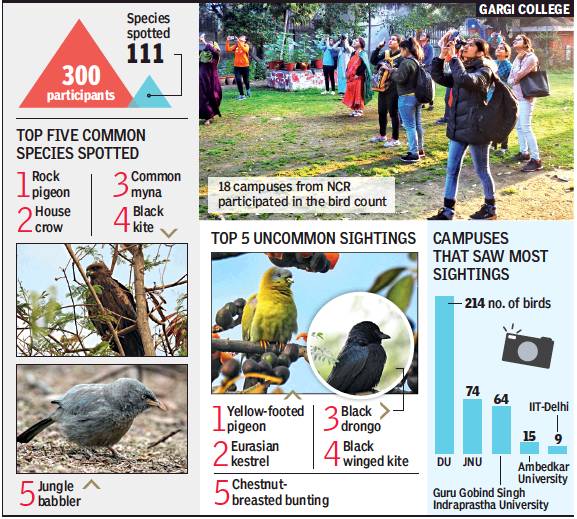
From: Mohammad Ibrar, Campus calling: DU is top choice for migratory birds, February 26, 2019: The Times of India
JNU And IP University Take Next Two Spots In Sightings
Delhi University saw the most number of migratory birds in the city with 214 of them being spotted on its campus during the Campus Bird Count, which was recently conducted by students.
The JNU campus saw 74 birds and IP University was a close third with 64 winged visitors being spotted in its complex. The students went around identifying different birds in their campuses between early morning and afternoon.
Campus Bird Count is a sub-event of the annual Great Backyard Bird Count. “It is a coordinated effort to document life of birds in multiple campuses across India. We include educational and training institutions, government institutions, research stations, corporate campuses etc. Broadly speaking, any moderate-to-large-sized area where people study, work or live,” said Misha Bansal, a JNU student and a birder. The event was held on February 15, 16 and 18 across the country at the same time.
Bansal added that this bird count was a ‘citizen science initiative’ through which even people who have got nothing to do with science or research can contribute in gathering baseline data. This has immense conservation value, she said. “It is a great way to get people interested in the rich diversity of birds in their surroundings,” Bansal said.
Several students from DU’s Hindu, Gargi and other colleges participated in the event. At Ambedkar University Delhi campuses — Kashmere Gate, Lodhi Road, Karampura, Dheerpur and Rohini — the count was organised by the Centre for Urban Ecology and Sustainability and saw active participation from students, researchers and university staff. Ajay Immanuel, a researcher at the centre, said they used binoculars and bird books, and conducted several 15-minute counts at various spots on each campus.
Late May: 177 species spotted in NCR
Jasjeev Gandhiok, May 27, 2019: The Times of India
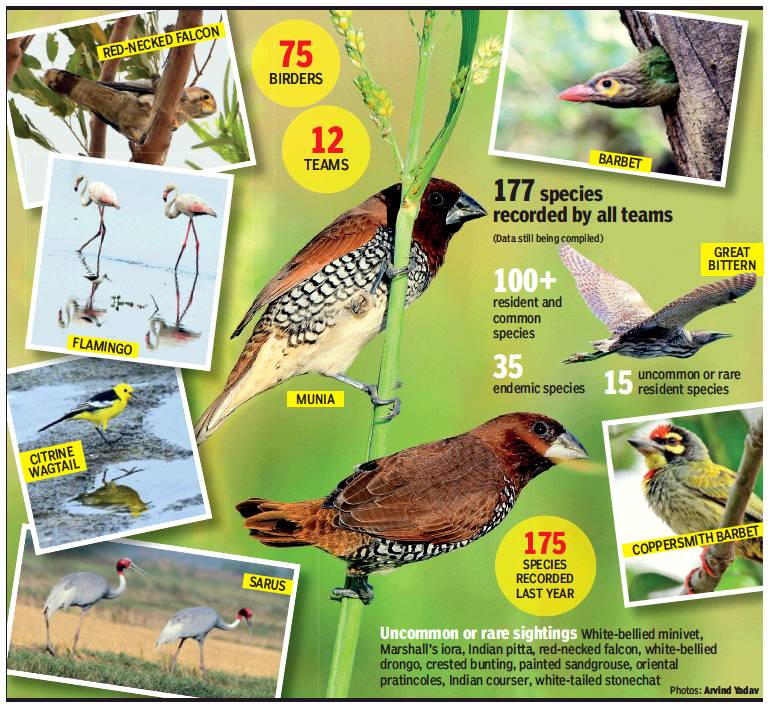
From: Jasjeev Gandhiok, May 27, 2019: The Times of India
Holding on to cameras, binoculars and a checklist, birders across Delhi-NCR set out at 5am on Sunday to record the species found in the region as part of the fourth Delhi Summer Bird Count. This year, 177 species were initially recorded between all teams, a slight increase from the 175 species spotted last year. The birders said an increase in rainfall could be an important factor for this change. The numbers may change after the final results are declared.
Over 450 species have been spotted in the NCR in the last 20 years. According to birder and organiser of the event, Kanwar B Singh, the 200 species recorded on Sunday is a significant number.
“This is an impressive figure considering that our winter event typically has an average day’s tally of around 250 species. The species count in our region is high in the winter months due to augmentation of our birdlife by migrants that arrive from September onwards and begin to depart after March,” said Singh.
This year, 12 teams of birders, each led by an experienced captain, set out at 5am towards popular haunts like the Yamuna floodplain, Okhla bird sanctuary, Najafgarh drain, Basai wetlands, Sultanpur and the forested habitats of the Ridge, including Asola, Sanjay Van, Delhi Cantonment, Rajokri, Mangar, Damdama and Bhondsi.
Singh said 15 rare and uncommon species were sighted this year, including the white-bellied minivet, Marshall’s iora, Indian pitta, rednecked falcon, white-bellied drongo, crested bunting, painted sandgrouse, Oriental pratincoles, Indian courser and white-tailed stonechat.
“These were mainly made in the Ridge area or on the Yamuna floodplain, once again highlighting their importance as good birding habitats. The resident species included 35 endemic species of India, meaning they are found nowhere else in the world except our country,” said Singh.
In addition, 100 resident species were recorded by most teams. “This is a huge positive insight emerging from the summer bird count that in spite of growing urban pressures, the NCR continues to support a very good resident birdlife,” Singh said.
In the Yamuna region up to Okhla, the important species sighted included whitetailed stonechat, striated grassbird, striated babbler, lesser whistling ducks and Bengal bushlark, among others. In the Najafgarh drain region up to Basai and Sultanpur, the important sightings included a large number of greater flamingos, Oriental pratincoles, grey-bellied cuckoo, cinnamon, yellow and black bitterns. The teams covering this vast area led by Brig Arvind Yadav recorded over 125 species.
Meanwhile, the Ridge and forested habitats in Delhi and Haryana, like Asola, Sanjay Van, Mangar and Bhondsi, recorded species like painted sandgrouse, Marshall’s iora and crested bunting, among others.
2019 Nov: 246 bird species
Jasjeev Gandhiok, Dec 1, 2019 Times Of India
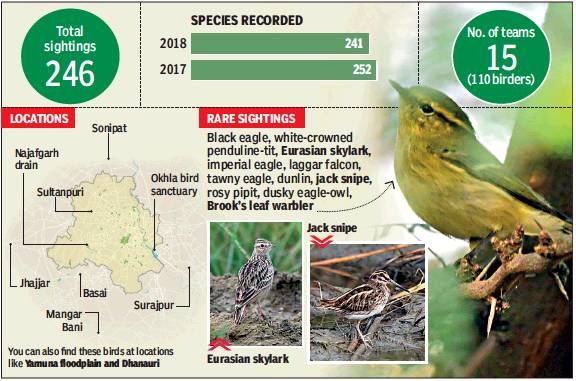
From: Jasjeev Gandhiok, Dec 1, 2019 Times Of India
A total of 246 bird species were recorded during the Winter Bird Count 2019 last Sunday, a slight increase from last year’s count of 241. A team of over 100 birders in 15 teams set out across different parts of Delhi and the National Capital Region and logged a number of important and rare sightings in the region, including the white-crowned penduline-tit, Eurasian skylark, imperial eagle, laggar falcon, tawny eagle, Brook’s leaf warbler and the dusky eagle-owl.
Of the 246 species recorded this year, over 100 were winter migrants. This year’s species sighting tally was less than the 252 recorded in 2017.The birding teams covered areas like the riverine belt of the Yamuna, including Okhla sanctuary and Wazirabad, wetlands of Gautam Buddh Nagar, including Surajpur and Dhanauri, the wetlands around Gurgaon, among them Sultanpur and Basai, Najafgarh drain up to Dhasna barrage, the Aravali belt towards Mangar Bani and the neighbouring districts of Sonipat and Jhajjar.
Kanwar B Singh, coordinator of the count, described the overall diversity recorded as good with some important sightings. Singh said the similar species count of the past few years signified that most wetlands were faring fairly well. “This annual event gives us a good idea of the nature of the regional birdlife, helps collect essential data on bird diversity in the region and boosts support for environment and nature conservation, while popularising bird-watching as a healthy pastime,” said Singh.
The white-crowned penduline-tit — a tiny wintering bird — was spotted by Pradyumna Vidwansa in Chandu village near Gurgaon after a gap of several years. Arvind Yadav, whose team sighted a Eurasian skylark at Mandothi in Jhajjar, Haryana, informed that this was a rate sighting in Haryana and NCR. “Both the Eurasian skylark and the white crowned penduline-tit have been recorded for only the third time in this region,” he said.
The birders said a few hundred greater flamingo are currently at the Najafgarh jheel. However this number is fewer than the arrivals in the last few years. Among the rare or uncommon waders reported by birders were the dunlin, jack snipe and Eurasian curlew. The enumerators also revealed the raptor count was higher this year when compared with the recordings of the last few years.
“Various teams reported resident and wintering raptors, including crested serpent eagle, booted eagle, imperial eagle, steppe eagle, tawny eagle, greater and Indian spotted eagles, long-legged and common buzzards, marsh Harrier, Eurasian sparrow hawk, osprey, common kestrel and red-necked laggar and peregrine falcons,” said Singh. “In addition, a black eagle, which is a magnificent forest eagle that is rarely seen around Delhi, was once again reported last Sunday by the team led by Tapas Misra and Tanweer Alam.”
The count in the forested areas of the Aravalis including Mangar Bani, returned interesting species like the white-bellied drongo, sirkeer malkoha and cinerous tit. Meanwhile, the birding teams noted the presence of Brook’s leaf warbler, Siberian stonechat, common kestrel and Isabelline shrike in NCR’s woodlands and grasslands.
2020
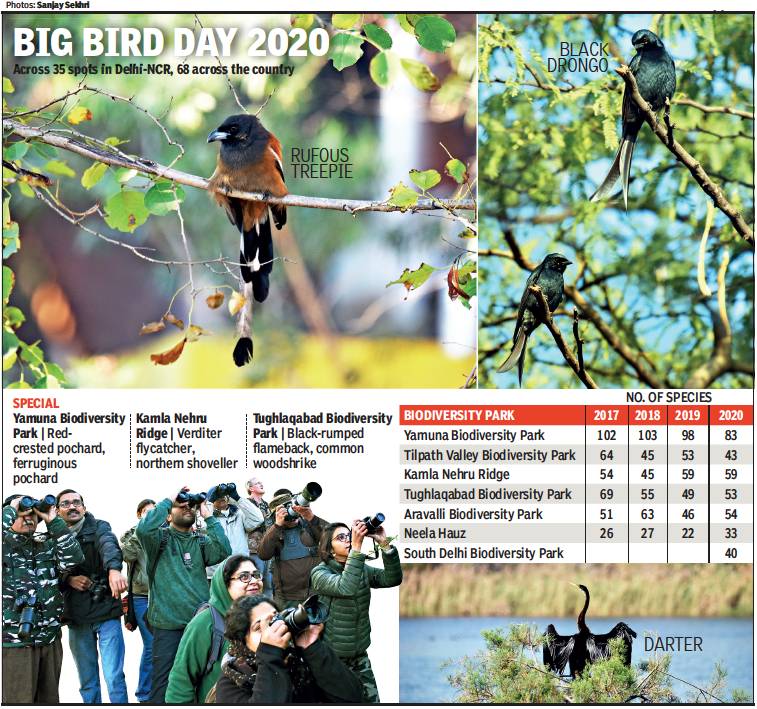
From: Ritam Halder, January 13, 2020: The Times of India
See graphic:
No. of bird species spotted in Delhi, 2017-2020
In brief
Jasjeev Gandhiok, January 1, 2021: The Times of India
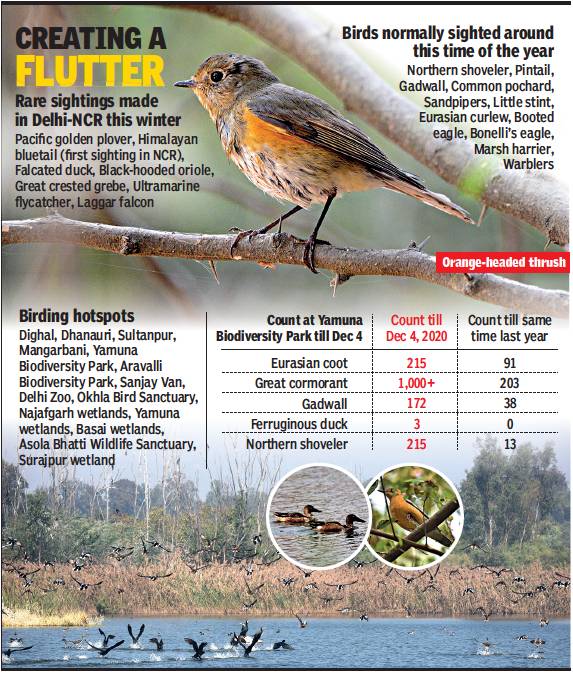
From: Jasjeev Gandhiok, January 1, 2021: The Times of India
For the first time, the Himalayan bluetail has been sighted in Delhi-NCR at Mangar Bani. Most wetlands in NCR have also been witnessing the arrival of a higher number of migratory birds this winter compared with last year.
Other rare sightings include the Falcated duck at Sultanpur, Pacific golden plover at Najafgarh, Great-crested grebe at Okhla Bird Sanctuary and Black-hooded oriole at Asola Bhatti Wildlife Sanctuary.
At the Yamuna Biodiversity Park, too, many species, including Gadwalls, Eurasian coot and Great cormorant, have been sighted in larger numbers.
“The Himalayan bluetail was initially misidentified, but a team went to Mangar Bani the next day and recorded it again. The Great-crested grebe, which is rare for NCR, was sighted at Okhla after a few years,” said Nikhil Devasar, a birder and author of the book “Birds About Delhi”. He added that most wetlands were doing well this year, including Dhanauri, Okhla and Mangar Bani.
Birder Kanwar B Singh said the Himalayan bluetail was a “vagrant” and probably came down from the mountains around Diwali when snowfall occurred in the Himalayas. “The bird generally does an altitudinal migration to the plains nearby. But Delhi is around 200km away, so it is slightly strange to see it here,” he added.
He further stated, “Dhanauri wetland and Okhla are doing well in terms of numbers so far. Najafgarh is the only concern as a new road is being constructed near the wetland, which might disturb the habitat and, impact the total area too.”
Sohail Madan, centre manager, Bombay Natural History Society at Asola Bhatti Wildlife Sanctuary, said apart from higher numbers, there were fairly strange sightings being recorded. He had spotted a Black-hooded oriole, a rare sighting for Delhi. He added that ducks were higher in number this year.
“We’ve seen unusual sightings like the Combed duck and Greylag goose, which were seen for the first time at Asola. We spotted 10 Steppe eagles together, which is another endangered species. The change in weather pattern might have impacted the numbers this year. Initially, the numbers were low, but they’ve suddenly gone up over the past month,” said Madan.
Data from YBP showed a higher number of species this year. For instance, 215 Eurasian coot were recorded till December 4 compared with 91 at the same time last year. Over 1,000 Great cormorants have been recorded at the park compared with 203 last year. “The early cold this year might be playing a part in birds arriving in larger numbers,” said Faiyaz Khudsar, scientist at YBP.
2021
Among the rare sightings made in 2021 were Eurasian griffon at Yamuna river, great bittern at Najafgarh lake, Marshall’s iora, and white-bellied drongo at Mangar village and Bhondsi forest. Birders said after many years, successful nestings of black-necked storks were seen at Sultanpur National Park.
In brief
Priyangi Agarwal, February 21, 2021: The Times of India
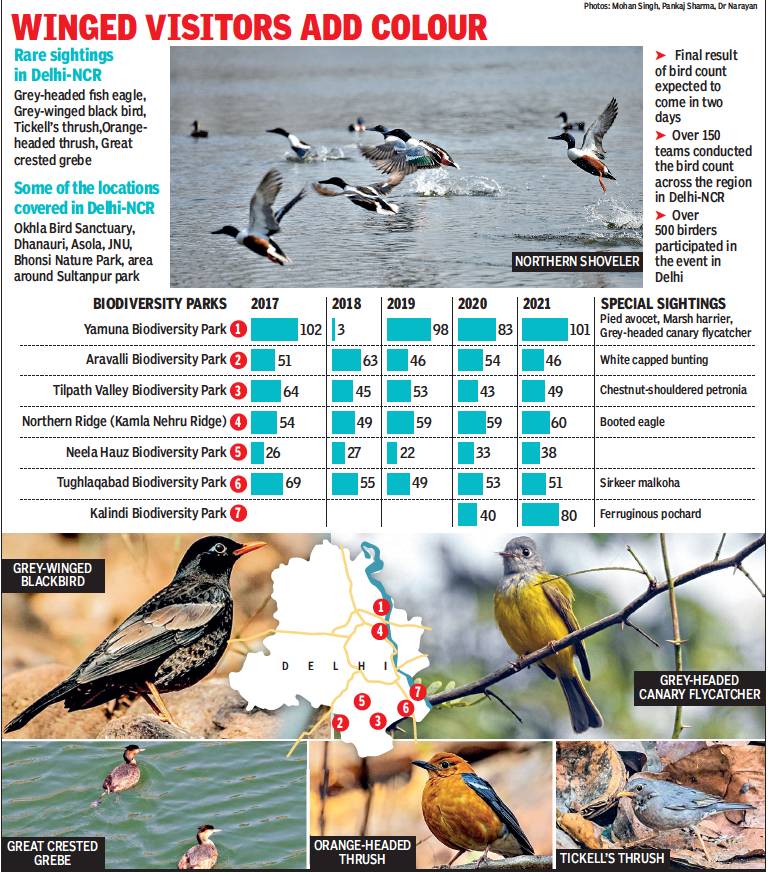
From: Priyangi Agarwal, February 21, 2021: The Times of India
The number of bird species has gone up at most of the biodiversity parks in the city compared with last year. The survey was done on the Big Bird Day, an annual event in the region where birders set out to record different species. The grey-headed fish eagle was among the rare birds sighted on Sunday. The final results of all sites in Delhi-NCR would be compiled in two days.
At Yamuna Biodiversity Park, the bird count increased from 83 in 2020 to 101 this year, while it doubled at Kalindi Biodiversity Park. Tughlaqabad Biodiversity Park reported a marginal decrease in bird numbers than 2020, while the species count dropped to 46 this year against 54 last year at Aravalli Biodiversity Park.
Faiyaz Khudsar, scientist incharge at Yamuna Biodiversity Park, who coordinated with the other parks, said, “Yamuna and Kalindi biodiversity parks are in the river floodplain and known for their functional wetland ecosystems for migratory birds. During winter, about 30 species of migratory birds come from Europe, Siberia, Central Asia and China at Yamuna Biodiversity Park in which Red-crested pochard and Ferruginous pochard are prominent among wintering ducks.” “Aravalli Biodiversity Park is known for its beautiful restored scrub jungle, thorn forest and Kullu and Dhawa, typical vegetation that is home to many migratory and resident terrestrial bird species,” added Khudsar.
The bird count took place for two hours at the seven biodiversity parks, but the duration varied from two to seven hours at other locations in Delhi-NCR. “The grey-headed fish eagle was spotted at Okhla Bird Sanctuary. Sunday was the fourth time ever when this bird was spotted in the region,” said Nikhil Devasar, organiser of the event.
The other rare sightings included grey-winged black bird, Tickell’s thrush, Orange-headed thrush, greater white fronted goose, black-necked grebe and great crested grebe. “We recorded 51 bird species at Asola, which was higher than last year. The highlight was the sighting of the great crested grebe for the first time this winter,” said Sohail Madan of Bombay Natural History Society.
The great crested grebe was also spotted near Najafgarh drain on the Haryana side. The other species there included five black-necked grebes. The grey-winged black bird, Tickell’s thrush and orange-headed thrush, which are Himalayan birds, were sighted at Bhondsi Nature Park near Gurgaon.
Over 150 teams covered different locations in Delhi-NCR. Apart from the prominent locations, some groups conducted the bird count at small sites like Humayan’s Tomb and Lodhi Garden. “Due to the pandemic, we formed small groups to maintain social distancing. As there was no fog and the sky was clear, many bird species were recorded,” added Devasar.
Big Bird Day Count
Jasjeev Gandhiok, February , 2021: The Times of India
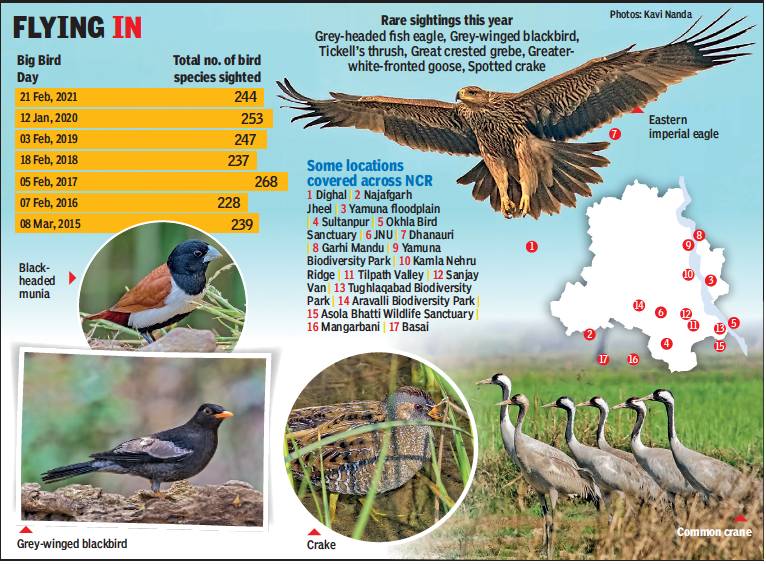
From: Jasjeev Gandhiok, February , 2021: The Times of India
Big Bird Day Count Sees Decline From Last Year, Warmer Conditions May Be To Blame
New Delhi:
A total of 244 bird species were spotted across Delhi-NCR this year during the Big Bird Day count on Sunday — a drop from last year’s count of 253 species.
While the conditions were much warmer compared with last year, birders said lack of coverage in certain parts of NCR may have led to a lesser count. In 2019, the count was 247, while 237 bird species were recorded in 2018.
The count also threw up only the fourth-ever sighting in NCR of the grey-headed fish eagle, which was spotted at Okhla Bird Sanctuary. Other rare sightings included grey-winged blackbird, Tickell’s thrush, great-crested grebe, greater-white fronted goose and the spotted crake.
Birder Nikhil Devasar, one of the organisers of the event, said the count was extremely successful under the current Covid-19 conditions and lack of coverage of certain areas in the NCR may have led to fewer species being spotted.
“One of the reasons for the low count is that we are still braving the pandemic. While the enthusiasm of birders cannot be marred, fewer people and teams were able to get out. To an extent, maybe the high temperature also played a role,” said Devasar, adding that 627 bird species were recorded across the country. He said these were good numbers for both the NCR and India.
Team Peregrine, which consisted of birders Pankaj Sharma, Punit Mehta, Mohit, Nitin Kumar, Bhrigu KP and Ashish Chaudhary, recorded the highest tally of 175 different species across the NCR. Kanwar B Singh, a birder who covered the Bhondsi forest area, said the conditions were ideal this year as low visibility was often a negative factor in January. “By this time, we also start seeing some returning migrants. The temperature might not be much of a factor as migratory birds only depart from mid-March onwards, but maybe some locations were not covered as properly as the previous years,” he added.
Birder Pankaj Gupta, who covered Budhera and Sultanpur, said a comparison would be done with last year’s findings to assess whether any major species were missing this year. “The numbers fluctuate each year. I don’t think we missed any major bird species this time around. Maybe some locations were not covered properly, but overall the count was good,” he added.
The bird count is held either in January or February every year to determine how each habitat in Delhi-NCR is faring, along with a bid to record rare sightings.
Migratory Birds Start Heading Back Home
Priyangi Agarwal, April 4, 2021: The Times of India
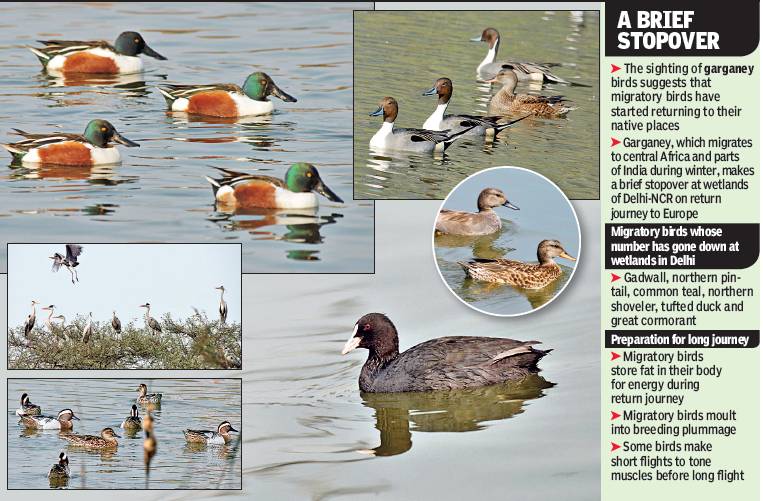
From: Priyangi Agarwal, April 4, 2021: The Times of India
Officials at Yamuna Biodiversity Park spotted the garganey duck at a wetland and inferred that meant the migratory birds had started returning to their native habitats. The garganey, which migrates to central Africa and parts of India during the winter, makes a brief stopover at Yamuna Biodiversity Park on its return journey to Europe. Birders disclosed that the number of other migratory birds in and around Delhi had also reduced, indicating they had begun flying back to Europe.
Faiyaz Khudsar, scientist in charge at the Yamuna Biodiversity Park, said the duck species was first spotted at the nature reserve in early winter when they halted while on their flight to other locations in India. “They are spotted again in March for around two weeks when they make a stopover while returning to their native habitat,” Khudsar informed.
“When the migratory birds arrived at Yamuna Biodiversity Park, many resident birds, including the little cormorant, Indian cormorant, darter and grey herons, shifted to narrow wetlands or marshy areas. However, with the migratory birds leaving the area, the resident birds have reoccupied the bigger wetlands of the park,” said Khudsar.
Among the species whose numbers have decreased in the last few days are the gadwall, northern pintail, common teal, northern shoveler, tufted duck and the great cormorant. Bird watchers said the migratory birds made preparations before beginning the long flight home. Most birds don’t fly for long during their stay in the area for threefour months, so make short flights to and from wetlands to tone their body muscles. “As the birds do not eat while flying, they store fat in their bodies for energy before flying to their breeding destination. They also moult and get their breeding plumage,” said Surya Prakash, a retired scientist from Jawaharlal Nehru University. “For instance, the brown-headed gull and blackheaded gull are mostly white in colour with greying feathers when they arrive at the onset of the winter. They turn completely dark brown for the breeding season.”
Nikhil Devasar, an avid birder, said that with the temperatures beginning to rise from February onwards and many wetlands suffering a scarcity of water due to the fewer number of rainy days since then, the migratory birds began returning to their home habitats from the third week of February. “All the species of migratory birds are heading back home and their numbers in Delhi are currently low,” Devasar reiterated.
2022
Wetlands: Bar-Headed Goose, Greylag Goose Spotted For First Time
Priyangi Agarwal, January 5, 2022: The Times of India
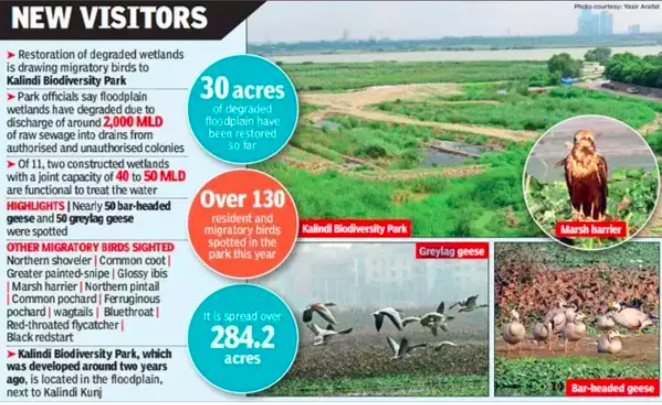
From: Priyangi Agarwal, January 5, 2022: The Times of India
NEW DELHI: The restoration of degraded wetlands at Delhi Development Authority’s Kalindi Biodiversity Park has helped attract migratory birds.
A flock each of nearly 50 bar-headed goose and greylag goose were spotted for the first time at the park while the northern shoveler, common coot and greater painted snipe have become a common sight there.
Kalindi Biodiversity Park, developed around two years ago, is located on the Yamuna floodplain at Kalindi Kunj in southeast Delhi. The floodplain wetlands have degraded due to the discharge of around 2,000 million litres per day of raw sewage into drains from authorised and unauthorised colonies. As part of DDA’s biodiversity parks programme, a team from the Centre for Environmental Management of Degraded Ecosystems (CMEDE) has been working on these wetlands, with 30 acres now restored and another 160 hectares still to be revived.
Scientist C R Babu, head of CMEDE, said, “The restoration of wetlands has led to migratory birds coming to Kalindi Biodiversity Park. The bar headed goose, recently sighted there, is otherwise mostly seen at the wetlands in Hastinapur and other places in the Gangetic plains.”
Yasir Arafat, scientist, Kalindi Biodiversity Park, said, “Over 130 resident and migratory birds can be easily spotted here. Last year, there were fewer species.” Among the visitors sighted are the marsh harrier, common coot, northern pintail, common pochard, ferruginous pochard, wagtails, bluethroat, red throated fly catcher and the black redstart. Around 40 glossy ibis have also been seen.
To arrest the degradation of the wetlands, CMEDE treats raw sewage through two constructed wetlands, of the 11 planned, that are fully functional now. These two have the capacity to clean 40-50 MLD of sewage. “A third constructed wetland capable of treating 500 MLD will start operating in two-three months,” said Babu. “However, it will take some time for the rest of the constructed wetlands to start working.”
The constructed wetlands are created using plants and boulders that prevent raw sewage from entering the Yamuna. The water is passed through different natural filters at different levels and around 25 different plant species are employed to biologically remedy the water quality. Different fishes have also been introduced in the wetlands.
A park official claimed, “The treated wastewater has the same quality as that of river water. The clean water passes through a filtration zone with gabions — or meshes filled with rocks, sand and soil — and ridges that create turbulence. The higher turbulence means higher oxygen saturation, more biodegradation of pollutants and better water quality.”

